steem
Tuesday, June 25, 2024
Friday, June 21, 2024
RUN (January 1986)
RUN primarily covered the Commodore 64/128 though it covered the VIC-20 early in its life and the Plus/4 and C-16 for about 5 minutes. The January 1986 issue includes:
Features
- Making The Video Connection - A tutorial for enhancing your VHS videos with titles, special effects and more from your Commodore 64. Some of the software used here includes Designer's Pencil (Activision), The Paint Shop (Broderbund), and Graphics Basic (HesWare).
- Commodore Carousel - Using your commodore to control a slide projector. Conceptually, this could be used for educational purposes to display images at appropriate times in combination with other software.
- The Creative Computer - How one person uses their VIC-20 as a television title generator, graphics design, speech synthesis, word processor, and music synthesizer.
- Pulsing Pictures - A type-in low resolution keyboard graphics animation program.
- Telecommunications...BRS/After Dark and The Knowledge Index - An overview of two online information retrieval services. These services let you search for information in categories such as science and medicine, business and finance, reference, education, and more. They basically provide access to various databases with bibliographic data. You paid by the minute or by the hour for access.
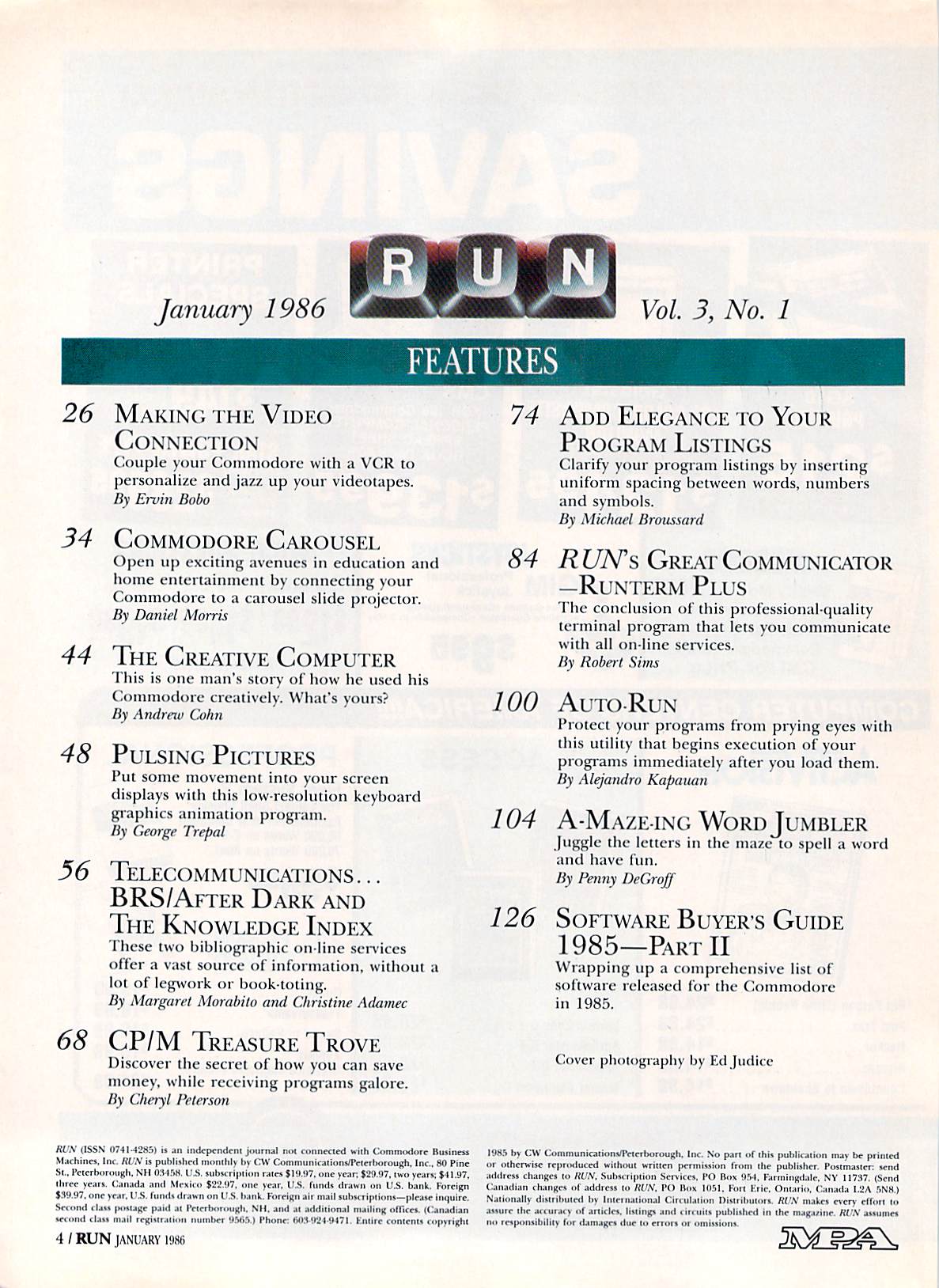
Table of Contents from the January 1986 issue of RUN
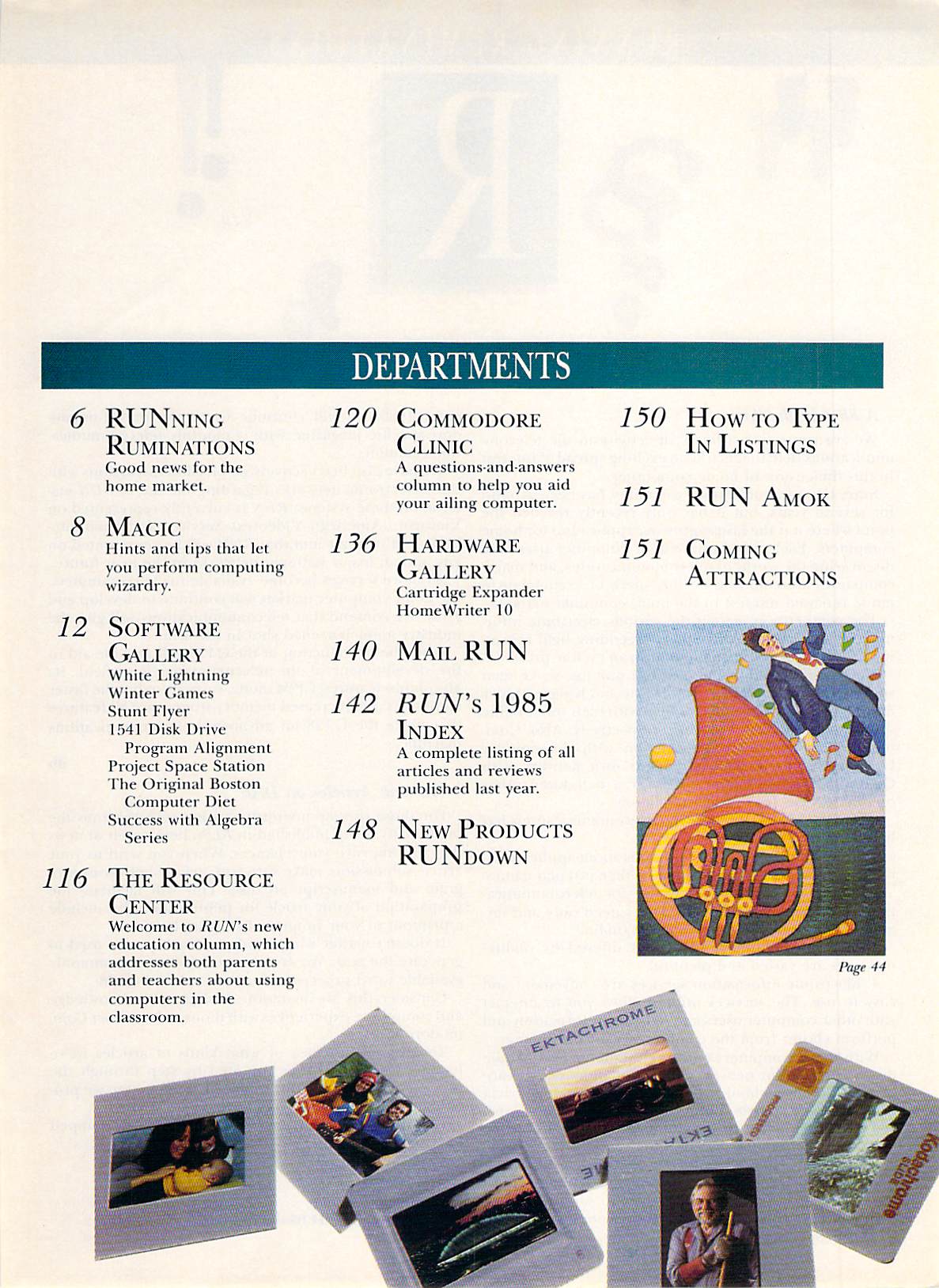
Table of Contents from the January 1986 issue of RUN (continued)
Departments
- RUNning Ruminations - Editorial on recent changes in the telecommunications field.
- Magic - Short programming tricks including a Christmas card, a trick to fly through walls in Zaxxon, an undelete utility, and more.
- Software Gallery - Reviews of White Lighting (a Forth based graphics development system), Winter Games (one of my favorites), Stunt Flyer, 1541 Disk Drive Alignment Program, Project: Space Station, The Original Boston Computer Diet, and Success with Alegbra Series.
- The Resource Center - A new column that focuses on Commodore computers in education.
- Commodore Clinic - Questions answered related to Passport's MIDI interface, 16-bit processors on an 8-bit bus, SX-64, repairs, using the MSD dual disk drive with the Commodore 128, and more.
- Hardware Gallery - A look at new hardware including a cartridge expander from Navarone Industries and HomeWriter 10 dot-matrix printer from Epson,
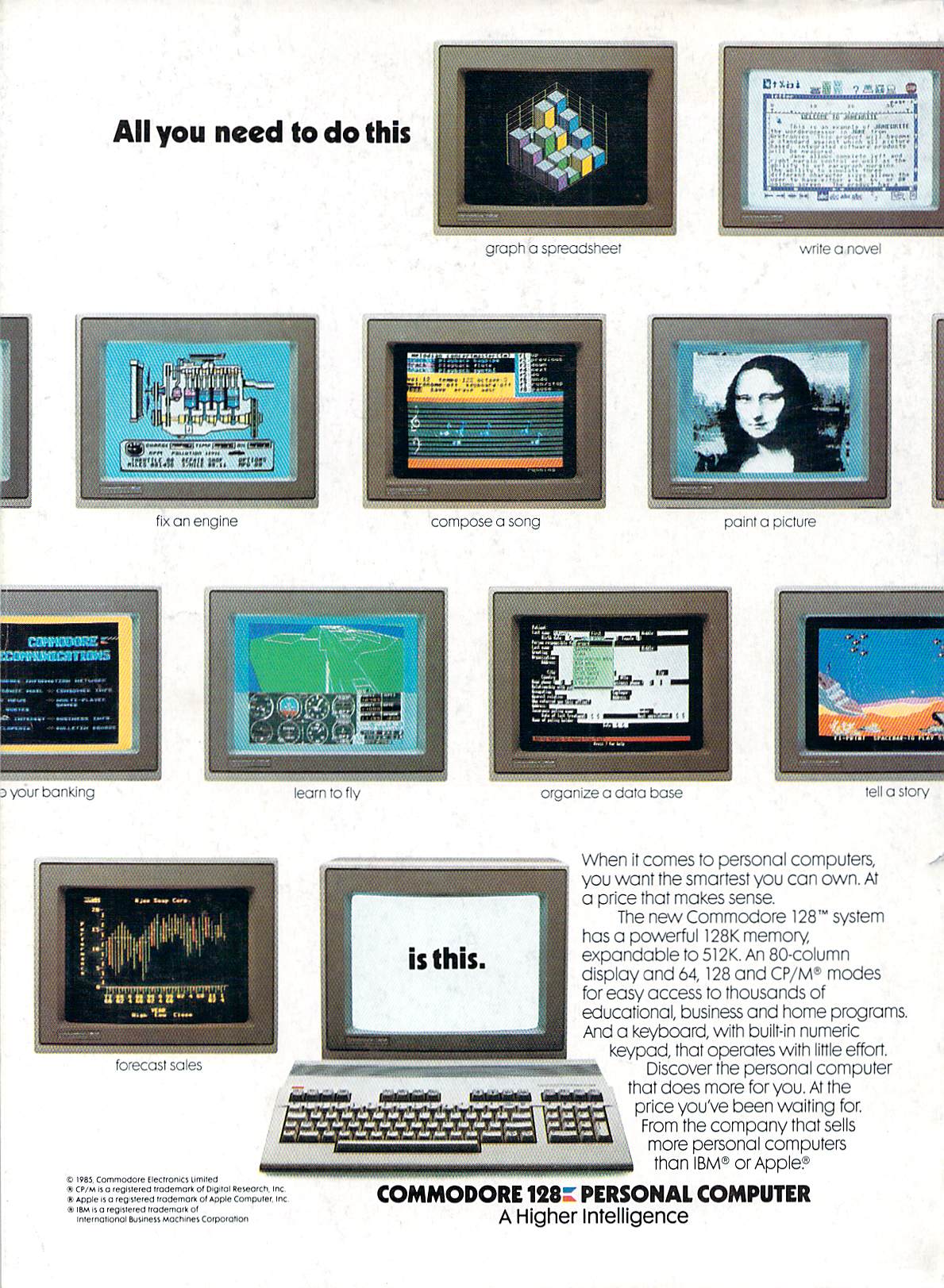
Back cover of the January 1986 issue of RUN
Read more: https://www.megalextoria.com/wordpress/index.php/2024/06/21/run-january-1986/
Wednesday, June 19, 2024
Compute! (March 1990)
Compute! Covered many computers over its long life. At one point, it specialized in 6502 based computers. By 1990, Compute! was becoming more PC centric but it was still covering other popular computers including the Apple II, Commodore 64, Amiga, and Macintosh.
Contents
- Buy Low, Sell High - An article on using your PC for investing. It covers dedicated software like Market Manger Plus 2.0 as well as subscription services like Value/Screen II which included software and monthly data disks. This data wasn't cheap though. $396 for a year. There are 15 software packages and online services examined here.
- My View - A guide to the kind of equipment and software you would need for financial planning type activities. These include a fast 8088 based to 80286 PC preferably with a hard drive, a 2400-baud modem, dot matrix printer, and various software.
- Smart Money - An overview of six personal finance software packages to help you balance your checkbook.
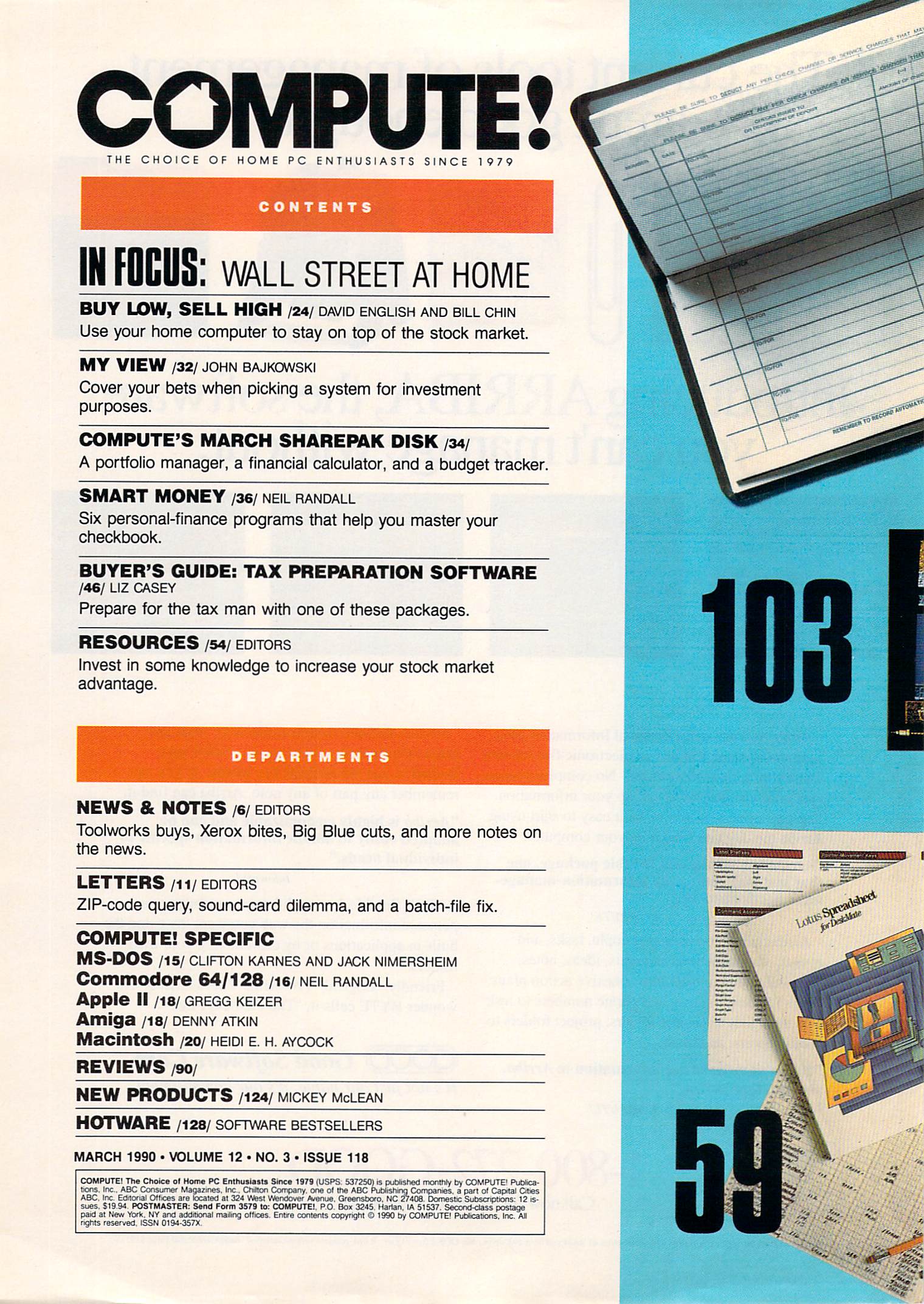
Table of Contents from the March 1990 Issue of Compute!
Departments
- News & Notes - Toolworks and Mindscape merge, Xerox sues Apple, Spectrum Holobyte sues Accolade over Tetris clone, Atari and other third parties sue Nintendo over marketing and licensing practices, new TurboTax/Quicken bundle, IBM cuts 10,000 jobs, Hot Circuits video arcade museum opens in Astoria New York, and more.
- Letters - Letters from readers about a QuickWrite review, a Zip code database, Game Blaster and Killer Kard (which became Sound Blaster before its release and was released at $239.95), and more.
- MS-DOS - Organizing files on disk, PC-Kwik Power Disk disk optimizer, Vq2 search retrieval tool, the OmniKey/102 keyboard, and more.
- Commodore 64/128 - The 1989 world of Commodore Show, RAMLink from CMD, GEORAM 512K memory expansion for GEOS, and more.
- Apple II - The Oregon Trailer on sale from MECC for $39.95 (I had this for the Commodore 64), Dino Days graphics and word processing software for kids, and more
- Amiga - VoRecOne voice recognition add-on, F-16 Combat Pilot from Electronic Arts, Jet Instrument Trainer, and more.
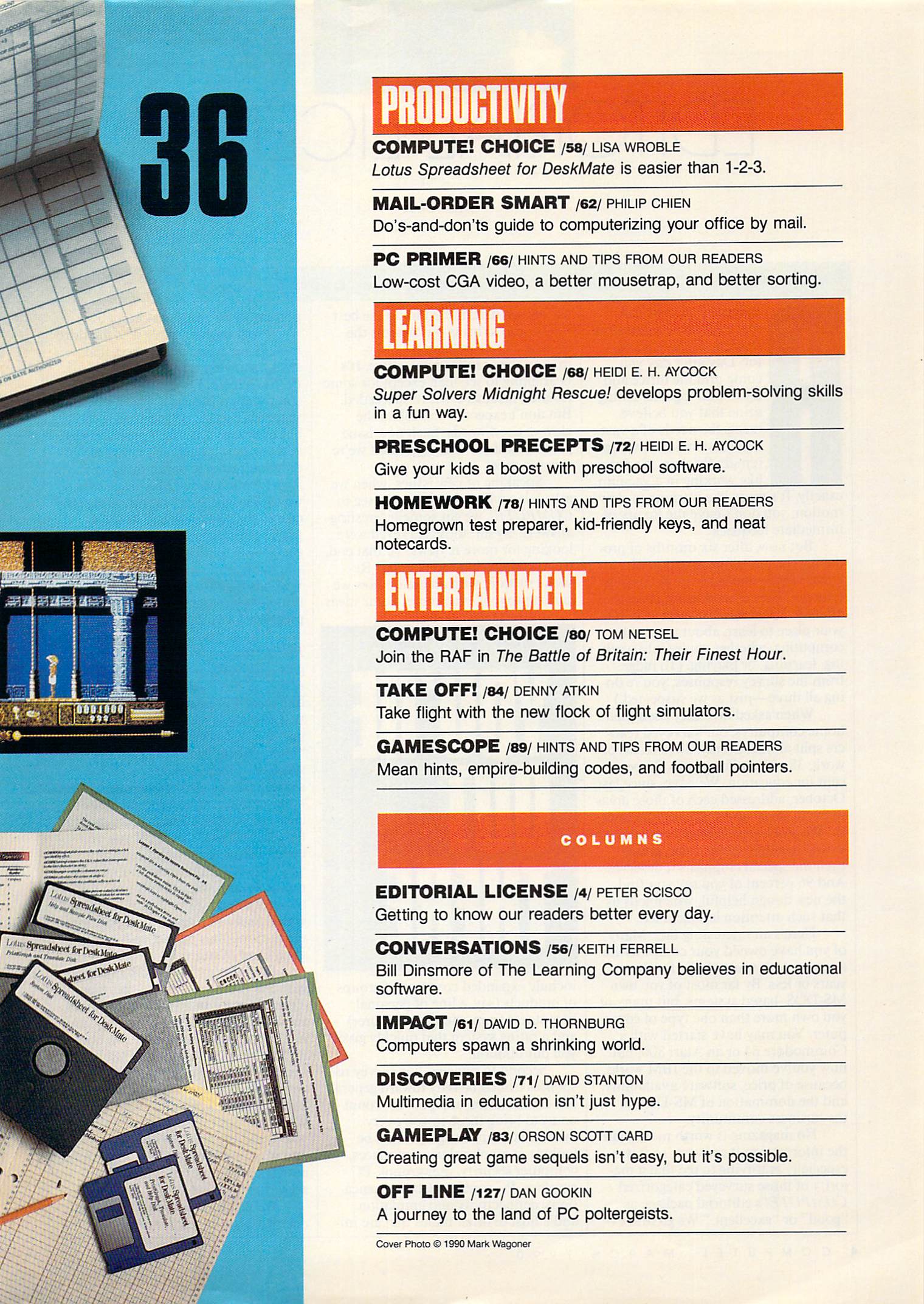
Table of Contents from the March 1990 Issue of Compute! (continued)
Productivity
- Compute! Choice - A comparison of Lotus Spreadsheet for DeskMate and Lotus 1-2-3.
- Mail-Order Smart - The advantages and common issues with purchasing computer software and hardware via mail order. I was buying stuff for my Commodore 64 via mail order around this time. Items I know I got that way include a new power supply, modem, printer, monitor, and a couple of games.
Learning
- Compute! Choice - A review of Super Solvers Midnight Rescue! from The Learning Company.
- Preschool Precepts - A guide to selecting good preschool software including an overview of various titles.
Entertainment
- Compute! Choice - A review of Lucasfilm Games' The Battle of Britain: Their Finest hour for DOS.
- Take Off! - An overview of the latest flight simulators including Flight Simulator 4.0, F-15 Strike Eagle II, A-10 Tank Killer, Blue Angels, and UFO.
Columns
- Editorial License - The results of a reader survey six months into the latest Compute! redesign.
- Conversations - Choosing the right home educational software.
- Impact - Using AppleLink to bring the world closer together.
- Discoveries - Useful multimedia in education. From Print Shop to generating screen dumps to using video cameras and digitizers, and more.
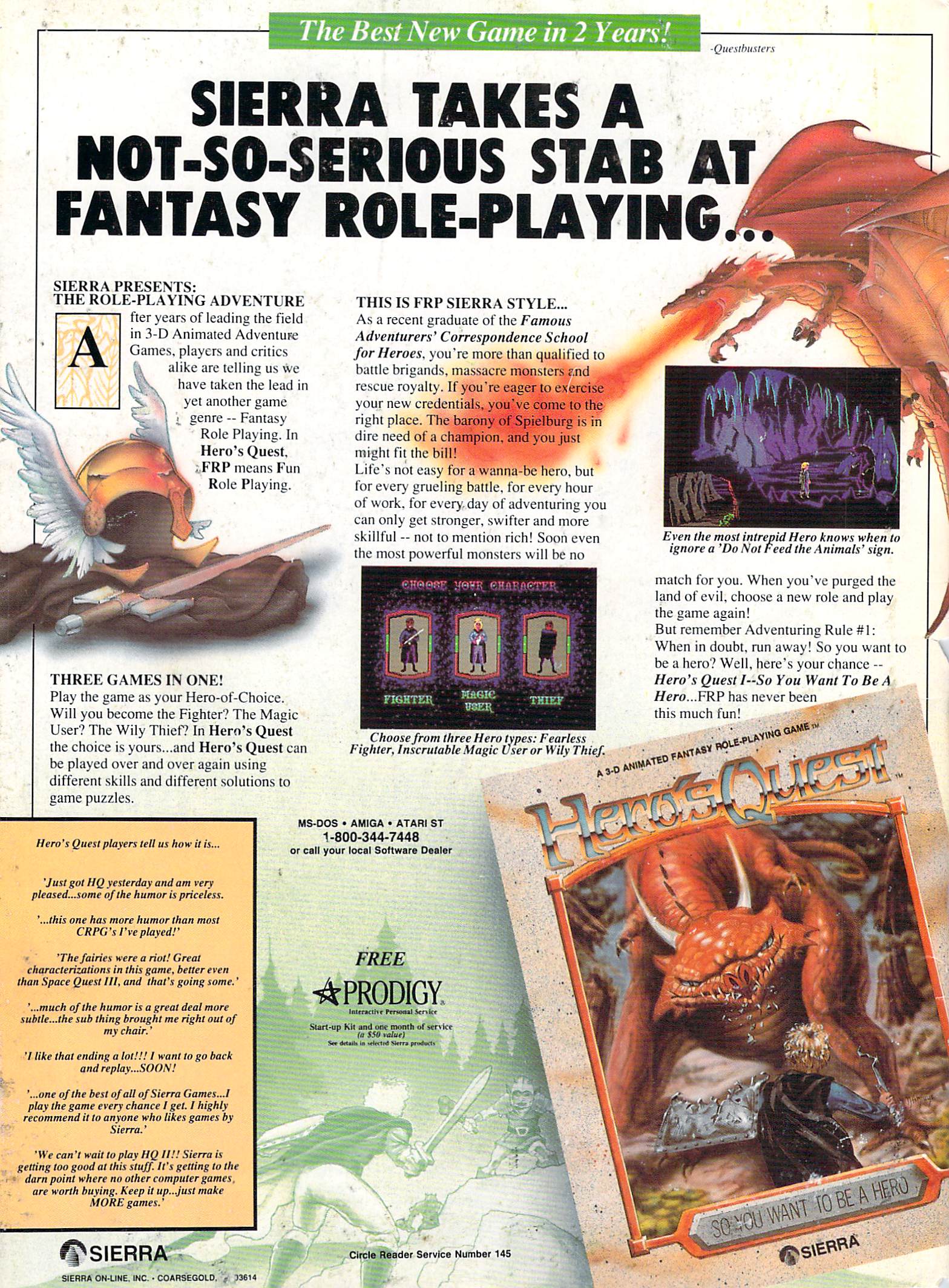
Back cover of the March 1990 Issue of Compute!
Read more: https://www.megalextoria.com/wordpress/index.php/2024/06/19/compute-march-1990/
Tuesday, June 18, 2024
Vintage Photos - Oestreicher (1305-1308)
See the previous post in this series here.
I had the opportunity to pick up a huge batch of slides a while back. These pictures span from as early as the late 1940s to as late as the early 1990s. These came to me second hand but the original source was a combination of estate sales and Goodwill. There are many thousands of these slides. I will be scanning some from time to time and posting them here for posterity.
Getting your pictures processed as slides used to be pretty common but it was a phenomenon I missed out on. However, my Grandfather had a few dozen slides from the late 1950s that I acquired after he died. That along with having some negatives I wanted to scan is what prompted me to buy a flatbed scanner that could handle slides and negatives, an Epson V600. It can scan up to four slides at a time with various post-processing options and does a decent enough job.
This set continues a large batch of slides that originally came from an estate sale and appear to have belonged to a locally well known photographer (or perhaps a friend or family member) from the Spokane Washington area and later Northern Idaho named Leo Oestreicher. He was known for his portrait and landscape photography and especially for post cards. His career started in the 1930s and he died in 1990. These slides contain a lot of landscape and portrait photos but also a lot of photos from day to day life and various vacations around the world. Here's an article on him from 1997 which is the only info I have found on him: http://www.spokesman.com/stories/1997/jan/04/photos-of-a-lifetime-museum-acquisition-of-leo/
Many of these slides had the date they were processed stamped or printed on them. I've found that in cases where I could verify the date, that this date has typically been the same month the photos were taken. In other words, I expect that in MOST cases these photos were taken relatively near the processing date.
Click the link below to also see versions processed with color restoration and Digital ICE which is a hardware based dust and scratch remover, a feature of the Epson V600 scanner I am using. There are also versions processed with the simpler dust removal option along with color restoration.
Most of these slides were in pretty bad shape so scans processed with color correction and Digital ICE are used for all but the first. These photos appear to have all been taken in the 1950s and are labeled as captioned below. I'm not sure why the first was labeled "Summer Pictures" as clearly that's not summer. Maybe it was meant ironically...
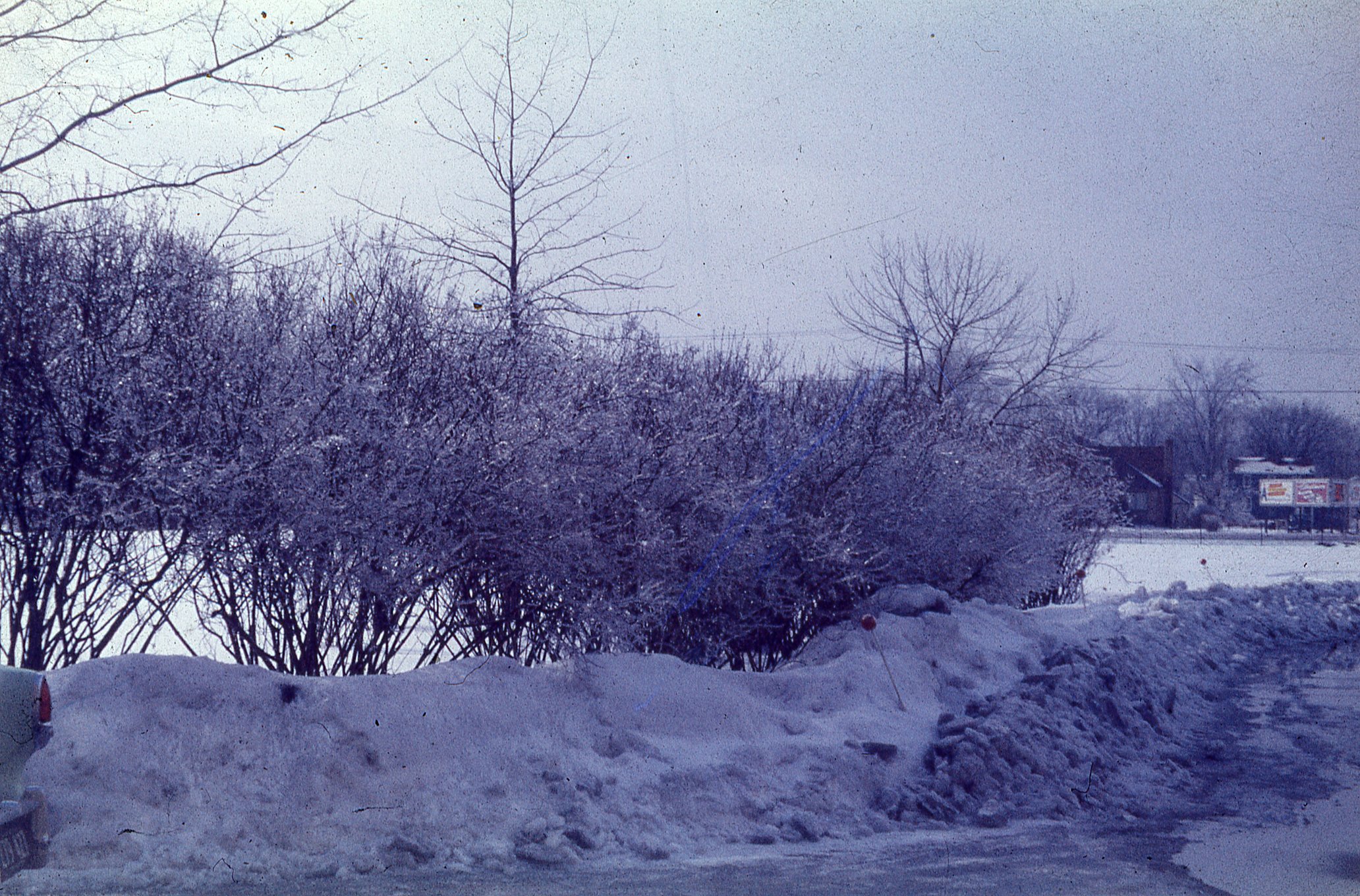
Summer Pictures - 1958 - Woodward front door
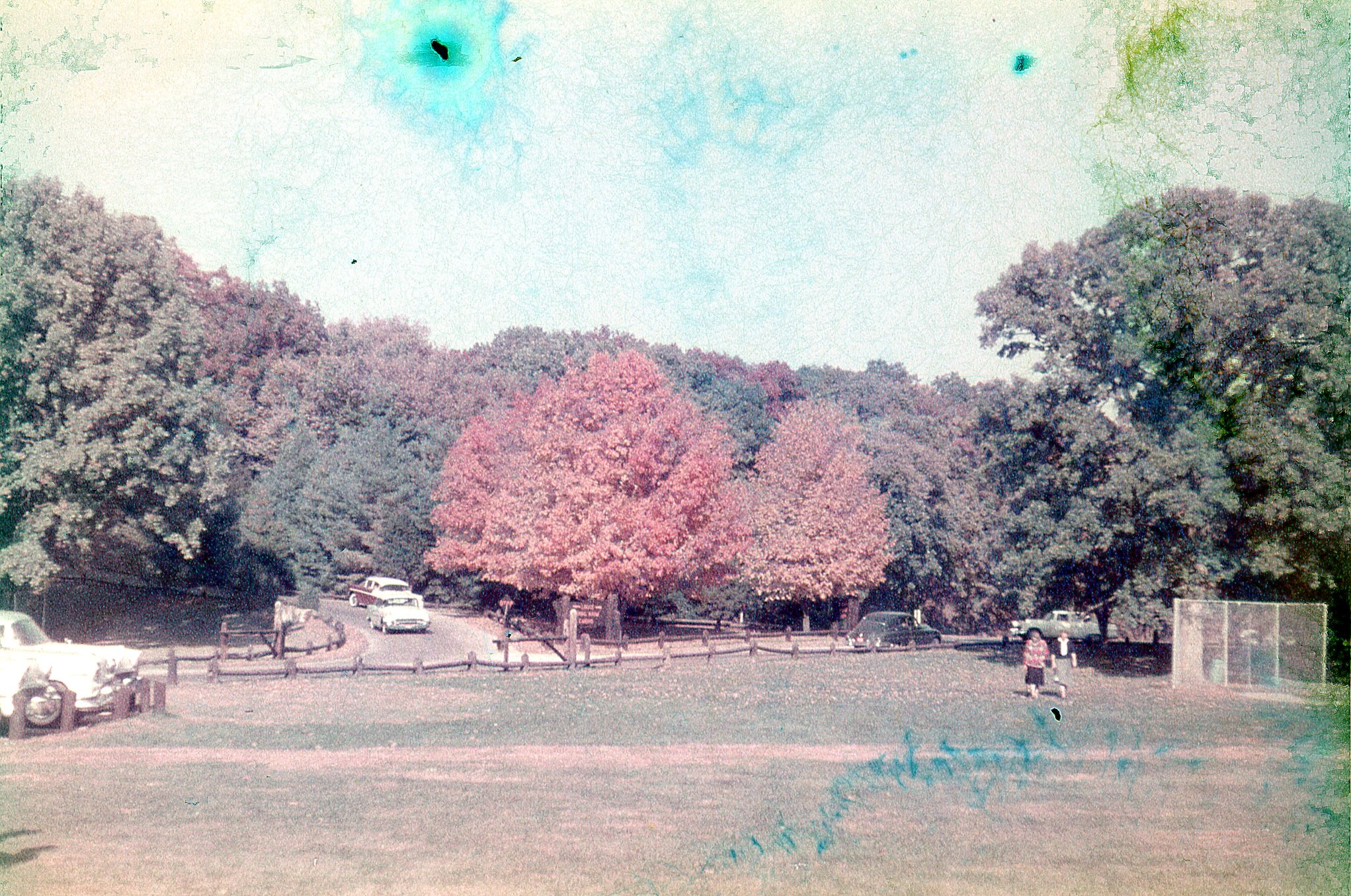
White Pines
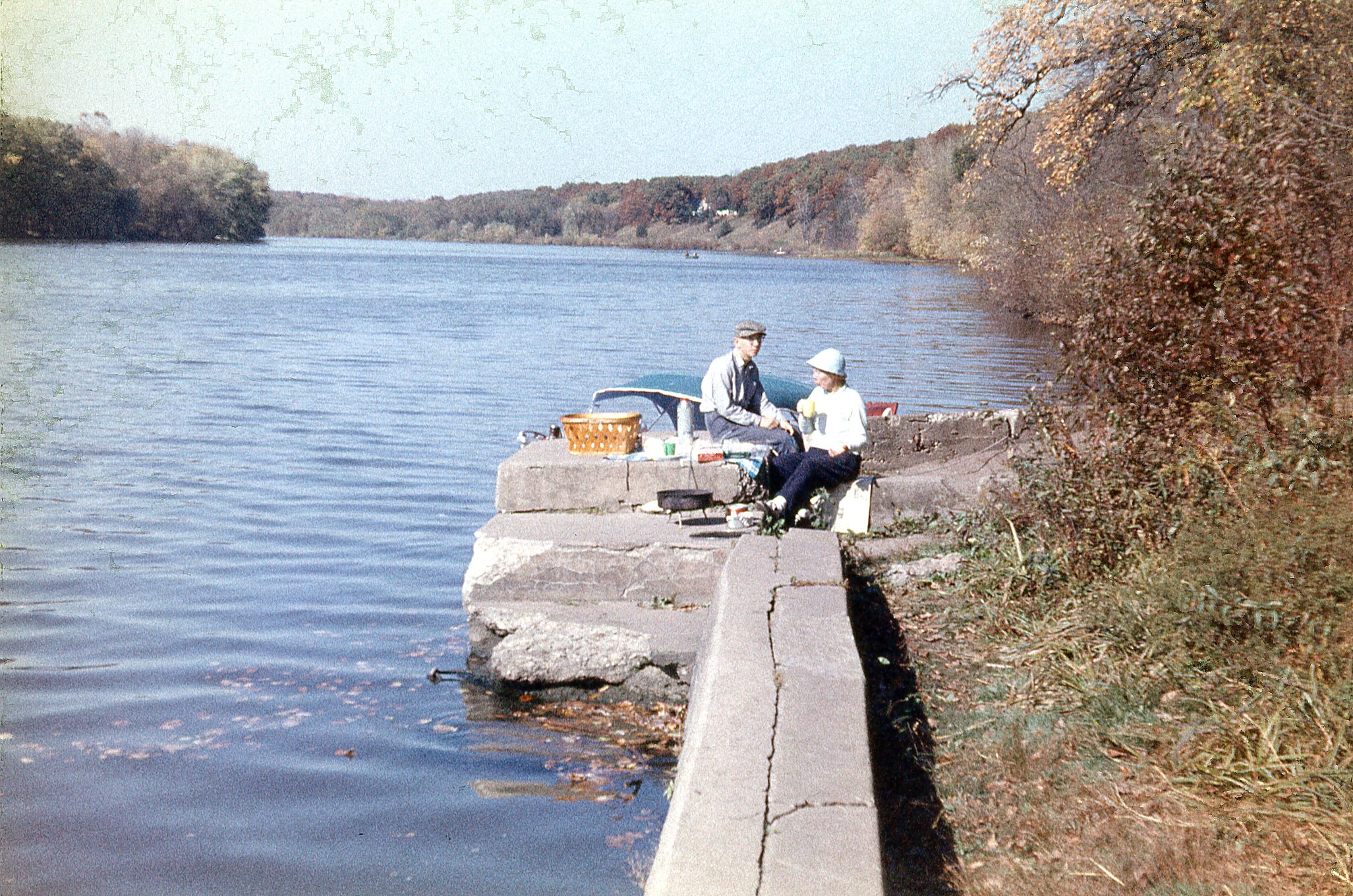
Below Blackbeach Statue - 1959
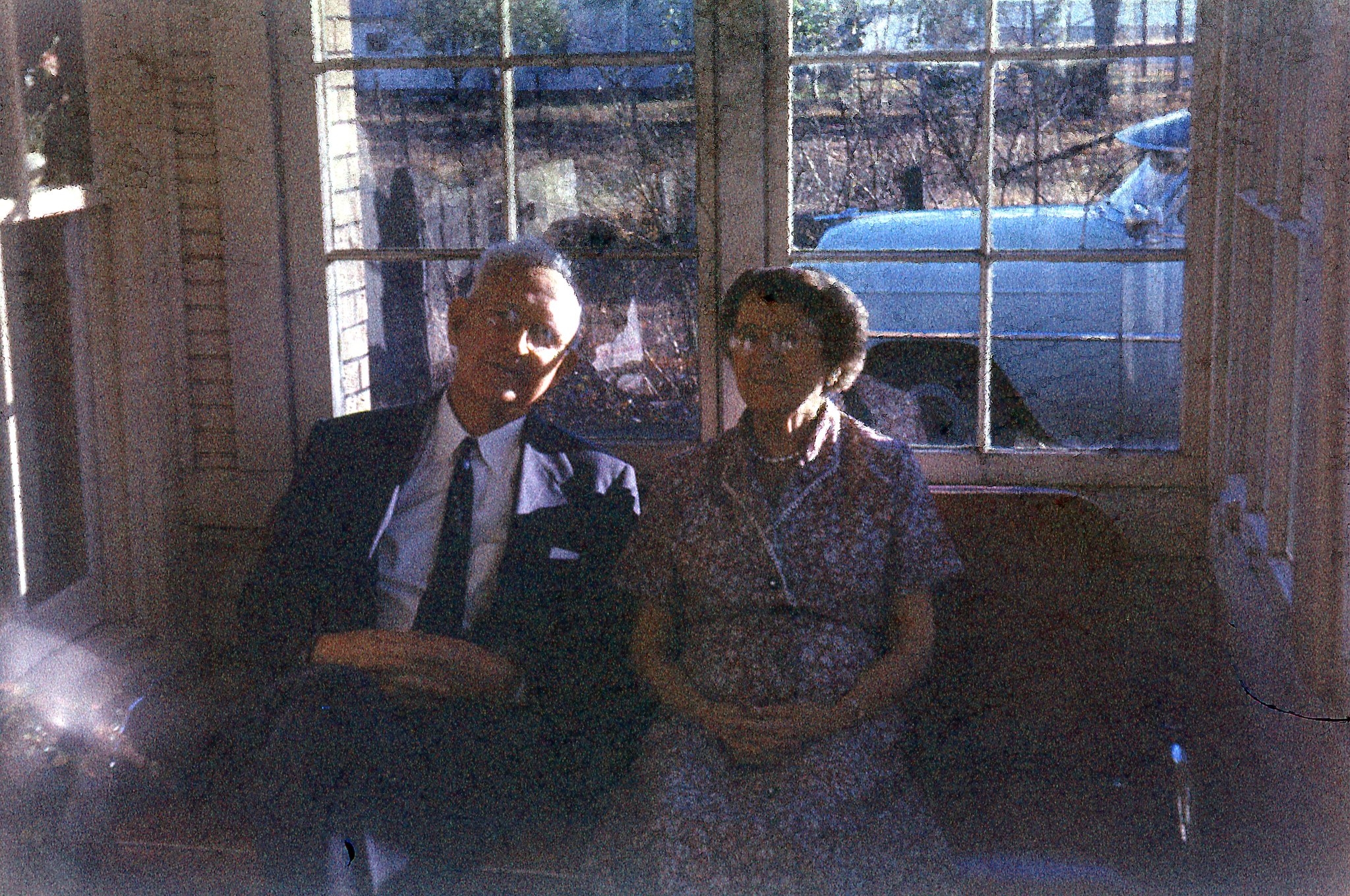
Mom & Will
The entire collection that has been scanned and uploaded so far can also be found here.
Saturday, June 15, 2024
Byte (September 1988)
Byte was probaby my favorite PC magazine while it was being published. It covered a variety of systems but by late 1989 there was more PC coverage than anything. That was probably just a product of what was popular. They had a lot of room to cover a lot of stuff though with the September 1989 issue having nearly 400 pages. It includes:
Products in Perspective
- What's New - WPC Bridge combo Apple II and PC computer from Cordata, ALR FlexCache 25386, 25-MHz 386 based machine from Hertz Computer Corp., 40-MB tape backup system from Tallgrass, 150-600 cps Honeywell 4/68 color printer, DSP32-PC floating-point array coprocessor card provides up to 25 mflops, Professional Write 2.0, $1000 CD-ROM drive for the Mac, PageMaker 3.0 for the PC, and much more.
- Short Takes - Short reviews of two 25 MHz accelerator boards for the Mac SE (TSI-020MX for $5000 and Radius Accelerator 25 for $1695-$2195), Turbo Prolog 2.0, SOTA MotherCard 5.0 (286 10MHz or 12MHz accelerator for $895-$995), Mach 20 accelerator card, Choice Words dictionary, and Testline Cache Drive Controller from Konan.
- Cover Story: IBM and Tandy...Same Channel, Same Plan for Growth - A comparison of the IBM PS/2 Model 70 and the Tandy 5000 MC. Both provided microchannel support. Micro Channel wasn't around very long and both IBM and Tandy would be out of the home computer business in a few more years.
- Product Focus: PostScript Printers Come of Age - An overview of PostScript compatible printers including the Apple LaserWriter IINT, Apple LaserWriter IINTX, Dataproducts LZR 2665, Dataproducts LZR 1260, General Computer Business Laser Printer, IBM 4216 Personal Pageprinter, PC Publisher Kit, ITT Qume ScripTen, QMS Color Script 100, Laser Connection/QMS JetScript, Laser Connection/QMS PS 800 II, QMS PS 810, Texas Instruments OmniLaser 2115, and Varityper VT600.
- Two for the Road - Reviews of two 80386 based laptops including the Toshiba T5100 and GRiDCase 1530.
- An 80386 with a Twist - Review of the AST Premium/386. It came in five configurations with the basic unit consisting of a 20-MHz 80386, 1 MB of RAM, and a 5.25" floppy drive for $5195.
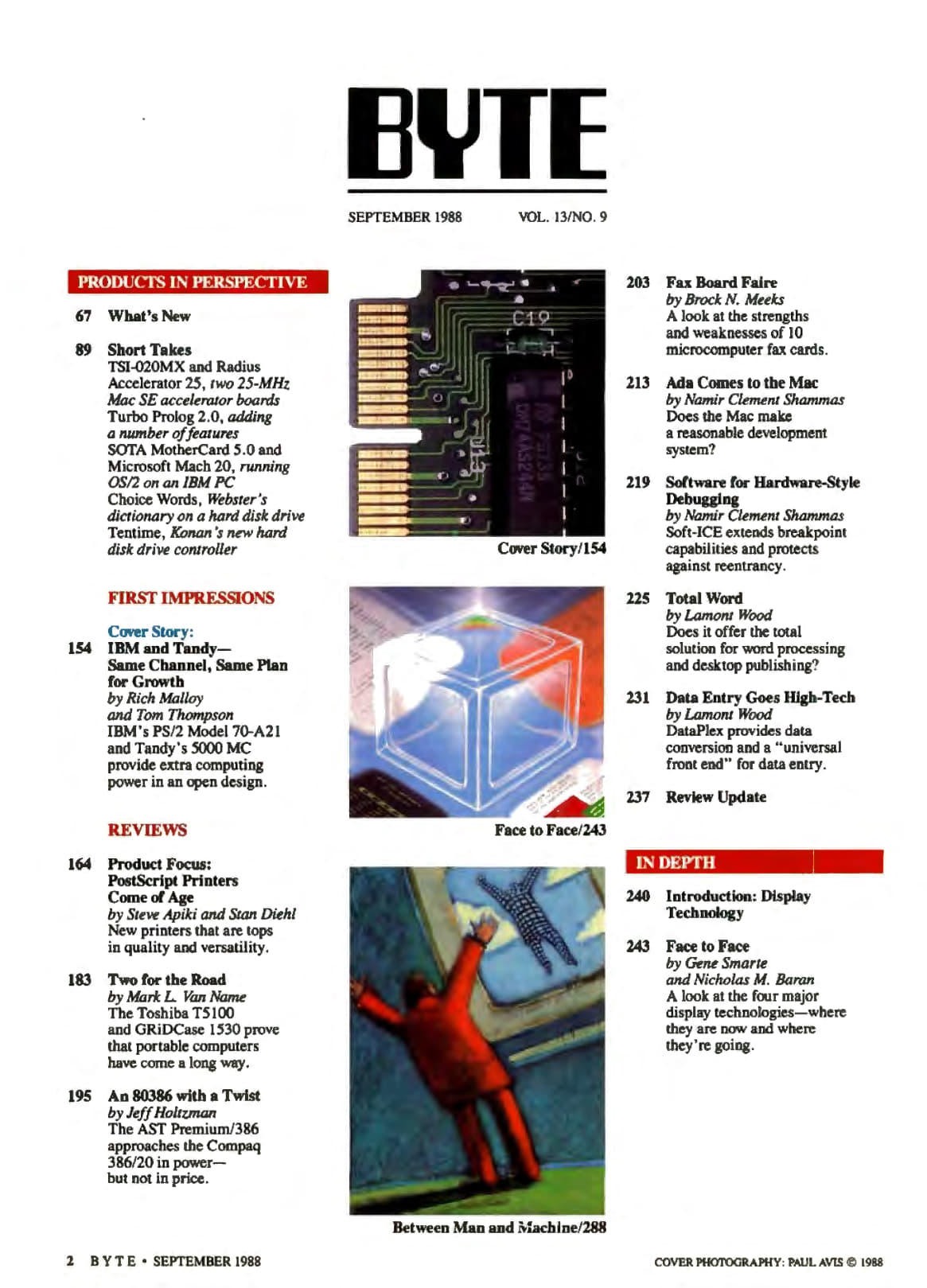
Table of Contents from the September 1989 issue of Byte
In Depth
- Face to Face - A look inside the various display types that were commonly in use. These include the CRT, gas-plasma, LCD, and EL (electroluminescent).
- Taking the Wraps of the 34020 - A look at the new 32-bit graphics microprocessor from Texas Instruments.
- Lighting the Way - A more detailed look at electroluminescent displays.
Expert Advice
- Applications Plus: A Wolf and a Killer Shark - A comparison of Word and FullWrite Professional word processors.
- Down to Business: Is More Alway Better - The Wang VS minicomputer vs. an IBM PC AT-compatible.
- Macinations: Comebacks, Backups, and Updates - A look at FoxBASE +/Mac, dMacIII, Apple Macintosh System Tools 6.0, 4th Dimension 1.06, FullWrite Professional 1.0, HyperCard 1.2, McMax Summer '87 Version, MindWrite 1.1, and QT-Mac40.
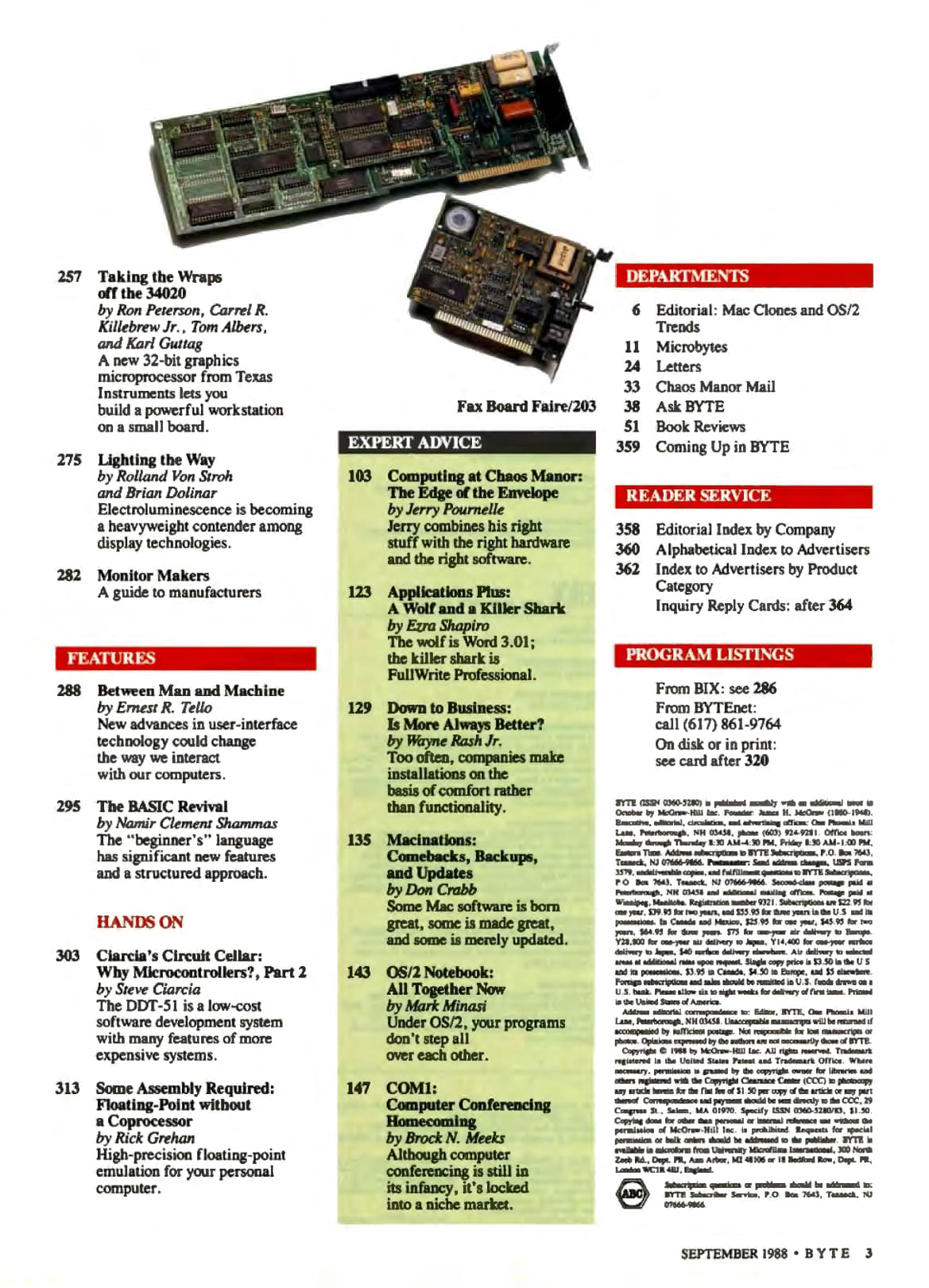
Table of Contents from the September 1989 issue of Byte (continued)
Features
- Between Man and Machine - A look at the latest in user interface technology. The focus here is on using gestures. Not as in modern mouse or trackpad gestures but using "data gloves" like something you would see in Minority Report.
- The BASIC Revival - The latest ANSI standard for BASIC turns it into a structured language, eliminating the need for line numbers, adding callable subroutines, multi-line functions and more.
- Clarcia's Circuit Cellar: Why Microcontrollers?, Part 2 - Using the DDT-51, a low cost PC based Intel 8031/8051 microcontroller development system.
Departments
- Editorial: Mac Clones and OS/2 - A look a a prototype Mac clone and some OS/2 user opinions.
- Microbytes - Cooperative processing on LANs with Paradox, a $3000 80-mflops co-processing card, gallium arsenide in pc chips, DRI released DR DOS, 386 math coprocessor from Weitek, and more.
- Letters - Letters from readers about recursion vs. iteration, fractions, programs vs. AI, and more.
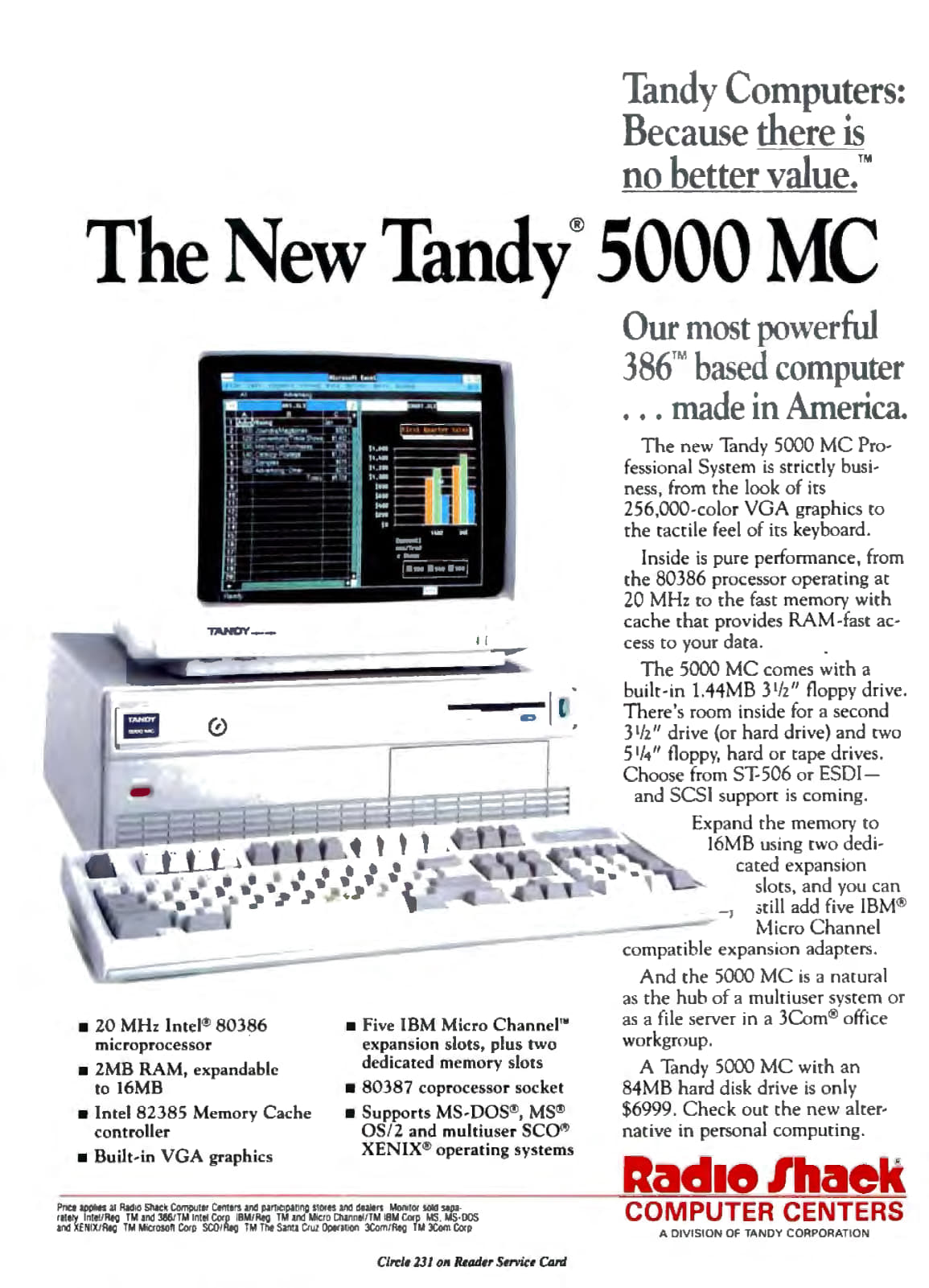
Back cover of the September 1989 issue of Byte
Read more: https://www.megalextoria.com/wordpress/index.php/2024/06/15/byte-september-1988/
Thursday, June 13, 2024
Byte (January 1979)
In 1979, you had to be into computers in a serious way to own one for your home. They were expensive, laughably underpowered by today's standards, and in most cases you had to build them yourself, including soldering the chips on the motherboard. Some businesses had computers but even that was relatively rare. The evolving standard at the time was 8080 or Z80 CPU based machine with an S100 bus for expansion and 64K of RAM or less running the CP/M operating system. There was still a lot of variety outside of that though. The January 1979 issue of Byte includes:
Foreground
- Build a Computer Controlled Security System For Your Home - Part one of a series on building a home security system based around the Intel SDK-85 single board computer.
- A computerized Mailing List - A series of type-in BASIC programs for managing a mailing list.
- Life Algorithms - Some algorithms are provided here in a pseudo-language resembling ALGOL based on Conway's game of Life.
- Polyphony Made Easy - A guide for interfacing a (music) keyboard to a computer that allows multiple notes to be played at once.
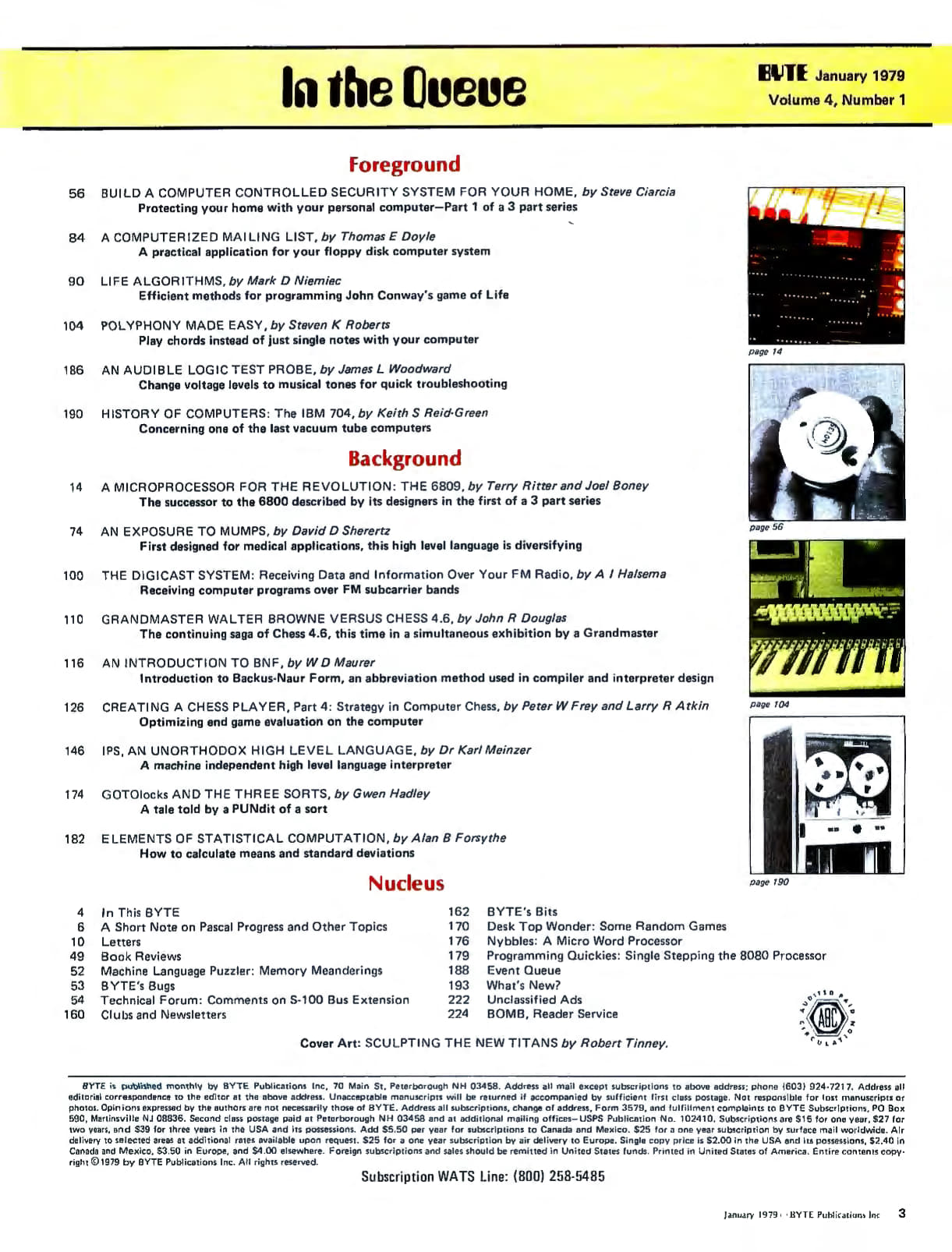 Table of Contents from the January 1979 issue of Byte
Table of Contents from the January 1979 issue of ByteBackground
- A Microprocessor for the Revolution: The 6809 - Part one of a series on the Motorola 6809 microprocessor. This part covers the design philosophy. The 6809 was one of the most advanced 8-bit processors but also one oft he most expensive. It found its way into some home computers like the TRS-80 Color Computer and arcade games like Star Wars, Defender, Joust and Robotron. However, its high expense led to the design of the inexpensive 6502.
- An Exposure to MUMPS - A detailed look at the Massachusetts General Hospital Utility MultiProgramming System.
- The Digicast System: Receiving Data and Information Over Your FM Radio - A proposed way that computer data could be sent via FM radio. As far as I know, this was never implemented.
- Grandmaster Walter Browne Versus Chess 4.6 - An early human vs. computer chess match.
- An Introduction to BNF - BNF is a standardized way to abbreviate computer language statements that would be used, for example, in manuals.
Nucleus
- A Short Note on Pascal Progress and Other Topics - A plan for making Pascal available on the Apple II.
- Letters - Letters from readers about computer insurance, Tokyo computer shows, using a DECWriter with an H8 system, and much more.
- Book Reviews - A reviews of Financial Analysis and Business Decisions on the Pocket Calculator by Jon M Smith.
- Machine Language Puzzler: Memory Meanderings - A puzzle in which the reader must figure out the operation of a given 8080 machine language program.
- Technical Forum: Comments on S-100 Bus Extension - A proposed 16-bit extension to the S-100 bus.
- BYTE's Bits - Tips for TRS-80 owners who are upgrading memory, info on the Personal Computing Festival of the 1979 National Computer Conference, solving the eight queens problem, and more.
 Back cover of the January 1979 issue of Byte
Back cover of the January 1979 issue of ByteRead more: https://www.megalextoria.com/wordpress/index.php/2024/06/13/byte-january-1979/
Monday, June 10, 2024
Byte (December 1983)
I used to think that no magazine, certainly no computer magazine, could compare to the size that Computer Shopper reached. However, there are some early magazines that give it a run for its money. For instance, the December 1983 issue of Byte comes in somewhere around a mind boggling 660 pages. Most novels aren't nearly that large. While there were of course a lot of ads, there was also a lot of contents, some of which includes:
Columns
- Keep Power-Line Pollution Out of Your Computer - A guide to building a powerline transient and noise suppressor.
- BYTE West Coast: Microsoft Windows - While Windows didn't really take off until version 3.0, the earliest versions still offered among the cheapest ways to use a GUI and mouse. Originally, Windows only required two 320K floppy disk drives and 192KB of RAM on an IBM PC.
Themes
- An Introduction to Integrated Software - The concept of integrated software existed long before the modern office suite. This article discusses three levels of integration: concurrency, shared technology and functional integration.
- Presentation and Form in User-Interface Architecture - The dichotomy of needing simpler user interfaces even as software gets more complex.
- Why is Software So Hard to Use? - In summary, creating easy to use software requires significant extra effort.
- Walt Disney and User-Oriented Software - How effective communication is the key to making great software.
- Making Life Easier for Professional and Novice Programmers - The evolution of programming tools and how visual tools will make programming easier.
- Simplify, Simplify, Simplify - How software design should emphasize logical design over technology.
- Integrating Voice in the Office World - How voice recognition and "voice as data" was expected to simplify the user interface in the business world.
- The Starburst User Interface - A look at Micropro's Starburst, a software package for implementing efficient menu designs.
 Table of Contents from the December 1983 issue of Byte
Table of Contents from the December 1983 issue of ByteReview
- The Texas Instruments Professional Computer - While sharing similar hardware to an IBM PC, the TI Professional Computer was not compatible. A strategy described as "brave" here but not one that would ultimately lead to success.
- The ATR8000 - The ATR8000 was a peripheral for Atari 8-bit computers that could add CP/M and DOS compatibility.
- The Hercules Graphics Card - A graphics card for the IBM PC that added monochrome graphical capabilities. This would become a standard.
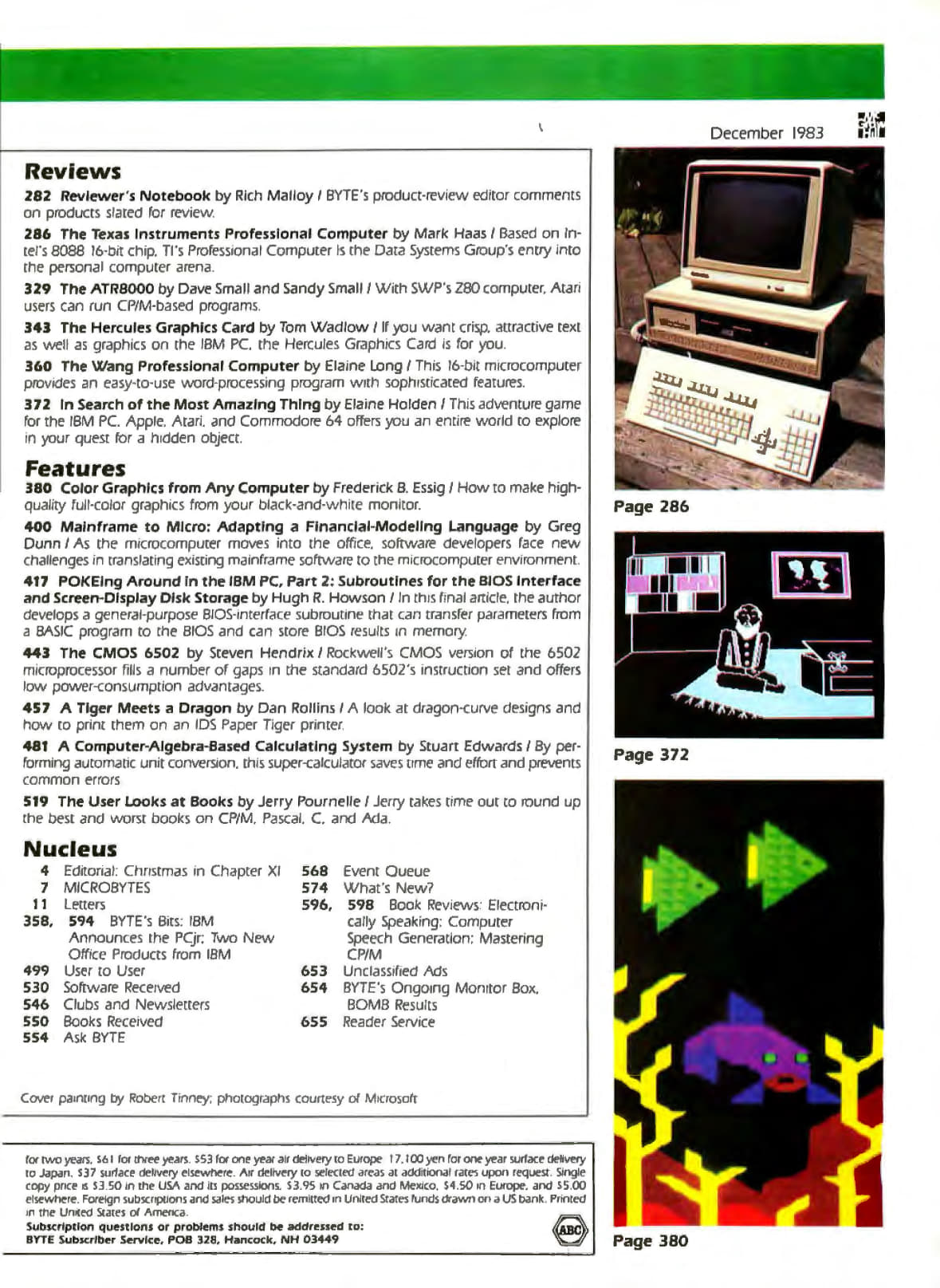 Table of Contents from the December 1983 issue of Byte (continued)
Table of Contents from the December 1983 issue of Byte (continued)Features
- Color Graphics from Any Computer - An article about recording color computer images on film including code examples.
- Mainframe to Micro: Adapting a Financial-Modeling Language - While the emphasis is on a financial modeling language, this article covers various issues with moving from mainframes to micro-computers.
- POKEing Around in the IBM PC, Part 2: Subroutines for the BIOS Interface and Screen-Display Disk Storage - The second of a two-part series on accessing IBM PC BIOS routines from BASIC programs.
- The CMOS 6502 - A new version of the 6502 processor that is more power efficient and includes new instructions.
Nucleus
- Editorial: Christmas in Chapter XI - It was a volatile time in the computer industry and this editorial points out that one of the things you should consider when buying computer hardware is whether or not the company you were buying from would likely still be in business in a year.
- MICROBYTES - IBM announces two versions of PCjr to be delivered in 1984; IBM announces color printer; National Semiconductor ships samples of new 32032 microprocessor; Wester Design Center begins test production of 65816 CPU; Wang introduces digitizing image scanner; Shugart introduce $6000 optical drive with 1 gigabyte of storage (non-erasable)...disks cost $150 each; and more.
- Letters - Letters from readers about the HP-75 portable computer, the Epson HX-20 (an early laptop), Unix, the TRS-80 Model 12 and Model 16, and more.
- BYTE's Bits - IBM PC announces the PCjr, what would ultimately be a failed attempt at creating a low cost "home computer", plus the new IBM XT/370 and IBM 3270.
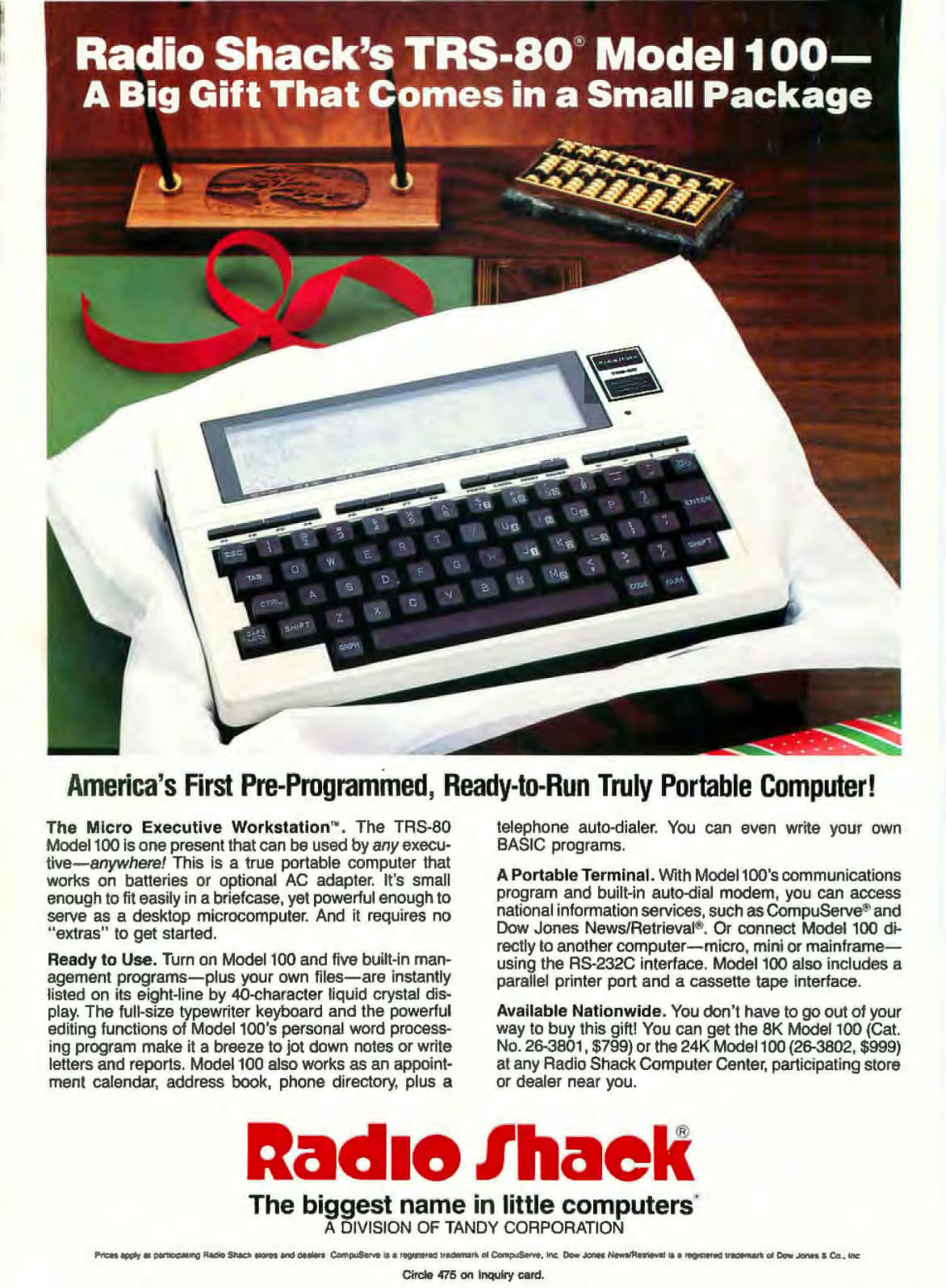 Back cover of the December 1983 issue of Byte
Back cover of the December 1983 issue of ByteRead more: https://www.megalextoria.com/wordpress/index.php/2024/06/10/byte-december-1983/
Thursday, June 6, 2024
Byte (March 1977)
Byte magazine (subtitled The Small Systems Journal) was a VERY early computer magazine with publication starting in 1975. This issue is from 1977. This is well before the IBM PC was introduced and there wasn't much in the way of what would come to be known as home or personal computers around. However, the Commodore PET, TRS-80 (Model I), and Apple II were all released year igniting what might be considered the first home computer war. Most other machines were either kit based (you build it yourself, often including soldering) or more business oriented (CP/M based machines). The main CPUs in use were the Intel 8080, Zilog Z80, and MOS 6502. This would remain true for several more years. The March 1977 issue of Byte includes:
Foreground
- Simplified Omega Receiver Details - Byte tended to be pretty technical. The earlier the issue, the more technical it tended to be. This article just goes into building something called an Omega receiver. I guess if you didn't know what that was, you didn't need to build one. According to Wikipedia, "An Omega receiver is a device that picks up very low frequency radio signals transmitted by Omega stations to determine a position. It was used in conjunction with the Omega navigation system, which was operational from around 1971 until it was shut down in 1997. Omega receivers helped ships and aircraft establish their locations by receiving signals in the 10 to 14 kHz range from a network of eight fixed terrestrial radio beacons." Sort of an early GPS system...
- Inexpensive Joystick Interfaces - Earlier computers wouldn't have joystick interfaces and there wasn't really a standard interface. Here's a guide for building your own.
- Flights of Fancy with The Enterprise - A type-in BASIC action game based on Star Trek in which you must hunt down and destroy the Klingon battle cruisers. It requires approximately 22K of RAM which was a pretty hefty chunk in those days.
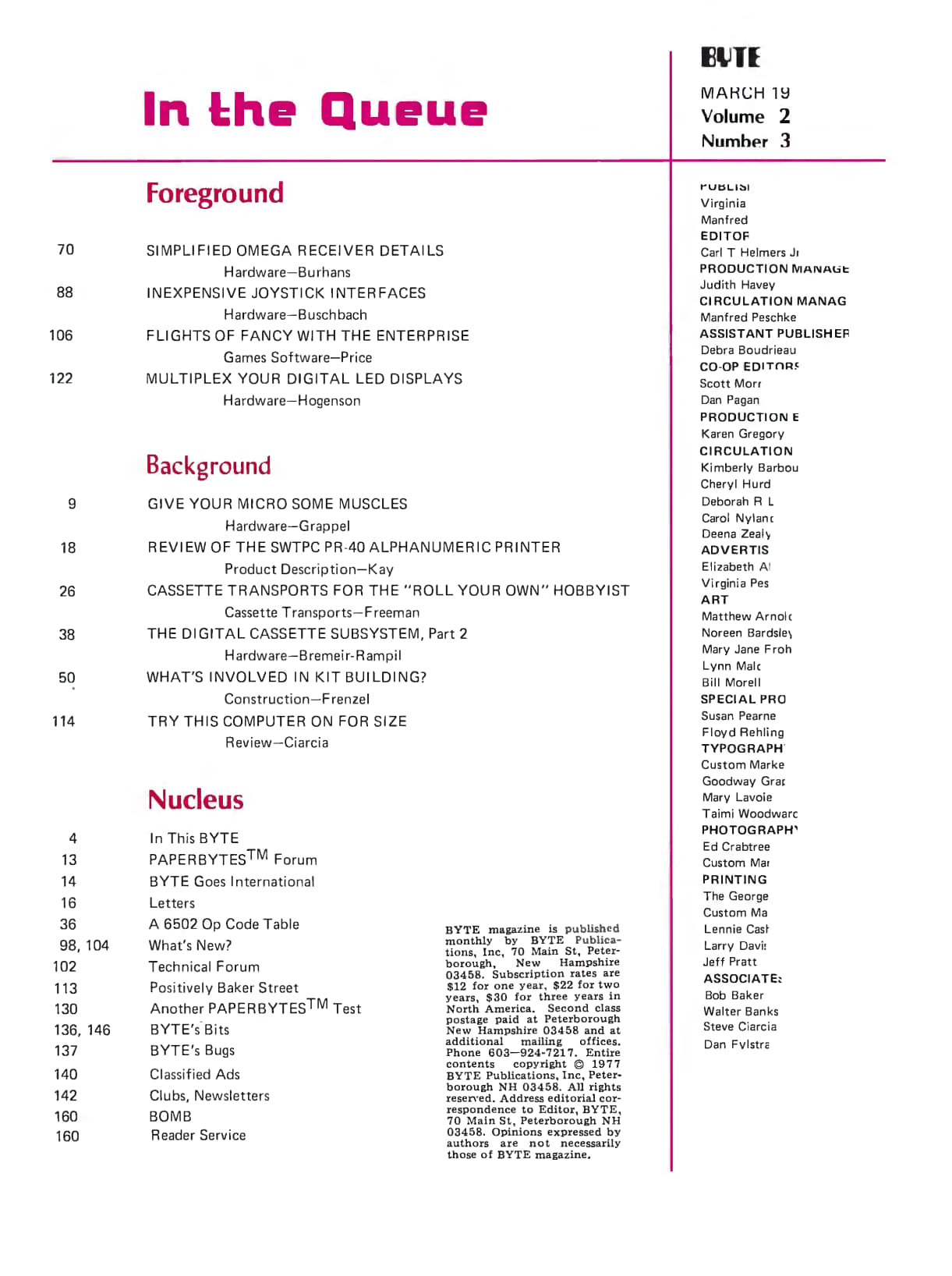
Table of Contents from the March 1977 issue of Byte
Background
- Give Your Micro Some Muscles - Using a computer to control external devices.
- Review of the SWTPC PR-40 Alphanumeric Printer - An early dot matrix printer that looks more like a telegraph machine. It is a 5 by 7 dot matrix printer capable of printing the 64 upper case ASCII character set with 40 characters per line at a speed of 75 lines per minute. It comes in kit form, meaning you have to assemble it yourself, for $250.
- Cassette Transports for the "Roll Your Own" Hobbyist - At this time, data storage for computer hobbyists was almost entirely done via cassette. Basically using the same cassettes and tape recorder devices you would use for audio. This article describes building your own cassette device starting with choosing a better transport mechanism than what you would typically find in cheap consumer devices.
- The Digital Cassette Subsystem, Part 2 - The second part in a series on the technical details of using cassettes for computer storage.
Nucleus
- PAPERBYTES Forum - Excerpts of various letters discussing machine readable printed software. Conceptually, this idea is similar to reading a barcode which was starting to become commonplace, for example, in supermarkets at this time. However, the idea here was to input entire programs via some kind of printed code.
- BYTE Goes International - Byte announces new Australian edition of the magazine.
- Letters - Letters from readers regarding arithmetic on the 8080, the ELIZA program, word processing on the Altair, cooling the CPU in an Altair 8800, bank switching with the RCA COSMAC 1802, and more.
- A 6502 Op Code Table - A reference chart that includes all the op codes for the MOS 6502 CPU. Useful for debugging hex dumps.
- What's New? - Phi Deck Tape Mass Storage for the Altair Bus (a tape drive for the Altair with up to 1 MB of storage), Computer Power & Light offers 8080A based computer system for $1863 completely assembled, new version of SC/MP processor from National Semiconductor, and more.
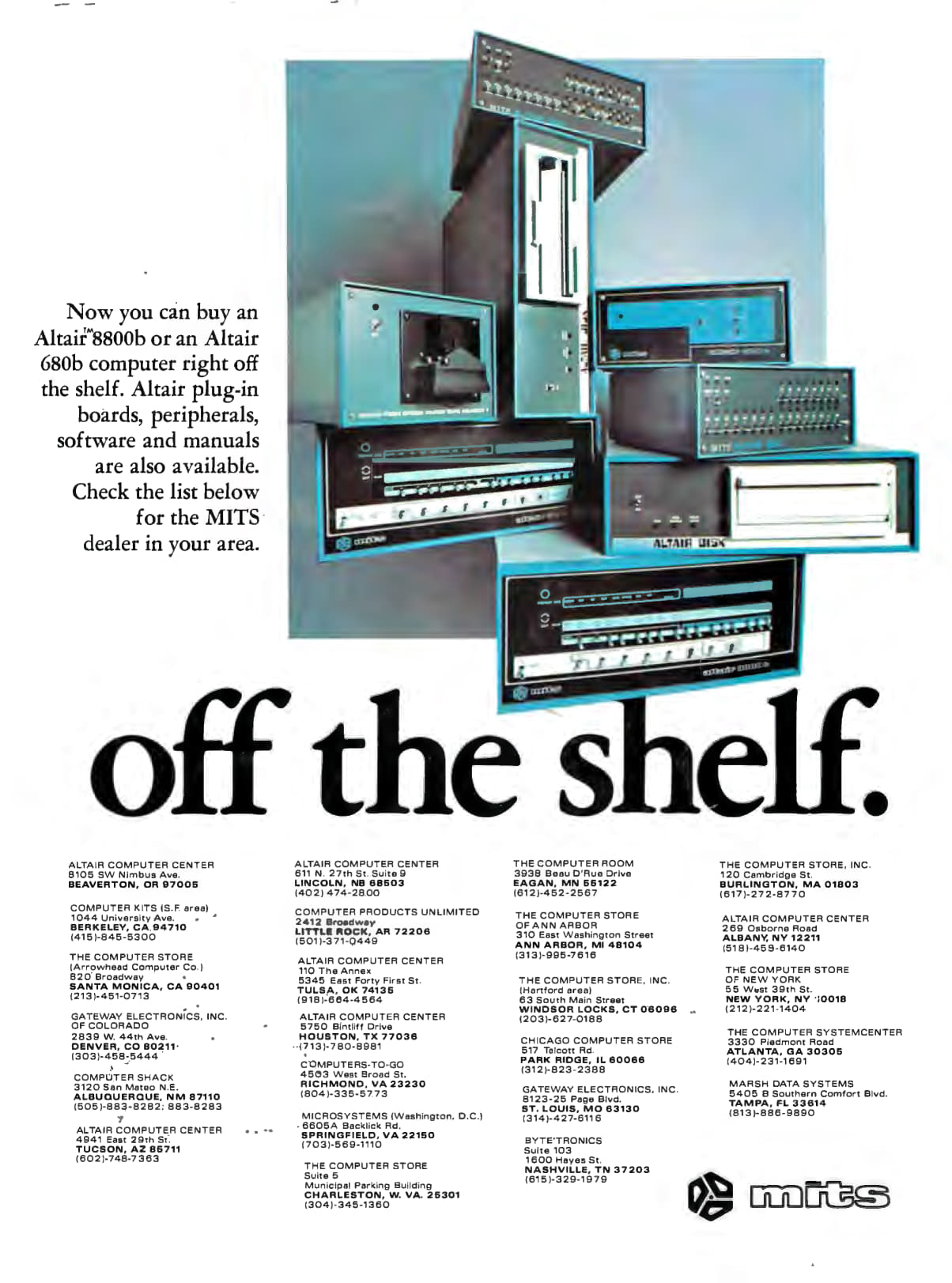
Back cover of the March 1977 issue of Byte
Read more: https://www.megalextoria.com/wordpress/index.php/2024/06/06/byte-march-1977/
Sunday, June 2, 2024
Byte (March 1987)
While Byte would basically become just another PC magazine towards the end of its life, in the mid to late 1980s it was still covering a variety of systems. The March 1987 issue includes:
Features
- Product Preview: The Commodore A2000 - A detailed preview of Commodore's Amiga 2000. This machine offered much greater expandability over the original Amiga 1000 and also optional PC compatibility.
- Product Preview: Turbo BASIC - A preview of this compiled version of BASIC.
- Ciarcia's Circuit Cellar: Build a Trainable Infrared Master Controller - Instructions for building a programmable universal remote.
THEME: Image Processing
- Probing Space by Camera - A history of image processing at NASA's Jet Propulsion Laboratory.
- Digital Image Processing in Art Conservation - Various photographic and image processing techniques can help preserve art and even discover previous versions of paintings.
- Introduction to Image Processing Algorithms - This image processing tutorial includes code examples.
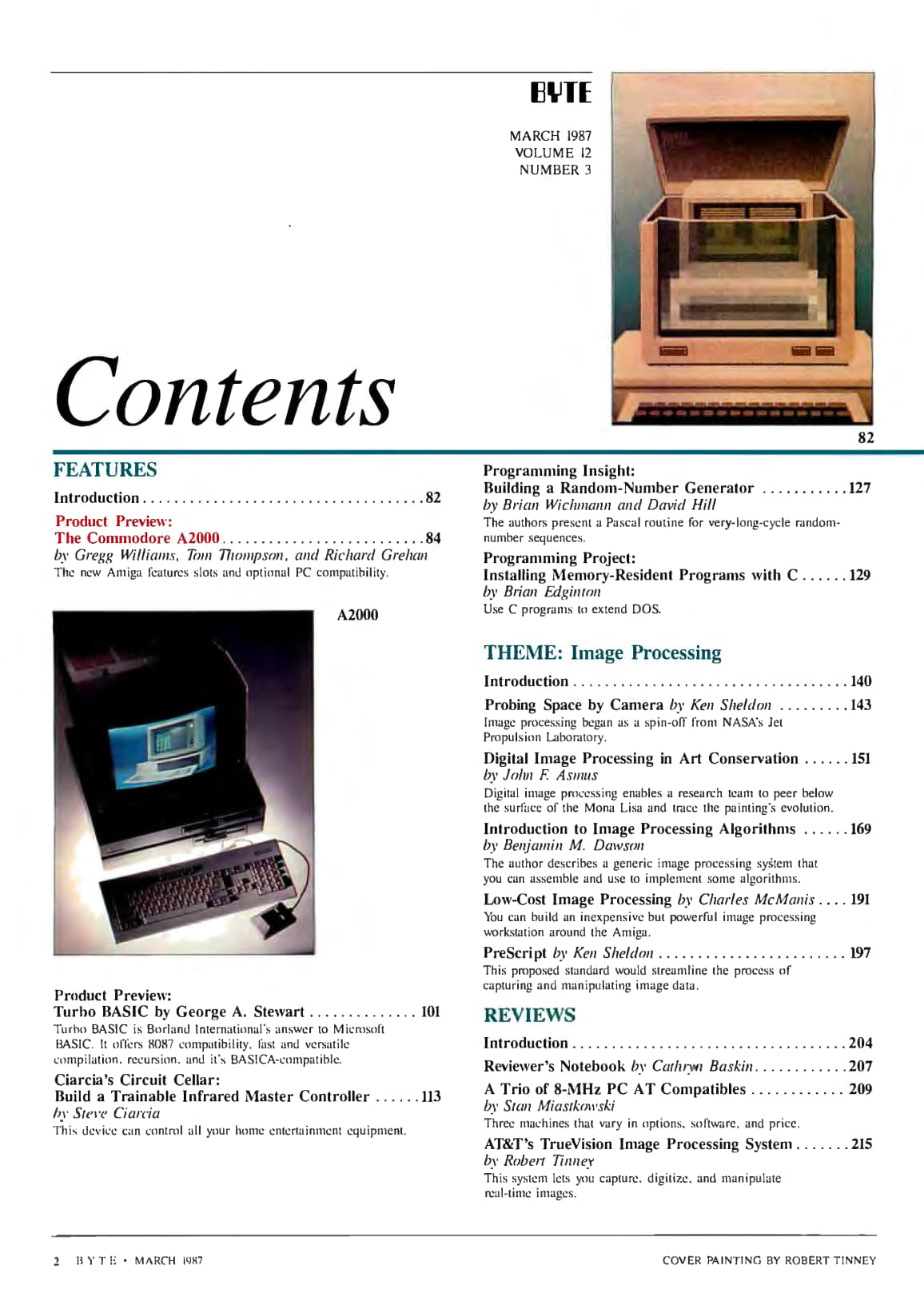
Table of Contents from the March 1987 issue of Byte
Review
- A Trio of 8-MHz PC AT Compatibles - A review of three PC AT clones including the NCR PC8 (starting at $3895), The Victor V286 (starting at $2195), and the QIC AT-Plus 1800 (starting at $1295).
- AT&T's TrueVision Image Processing Systems - TruVision is a software package for digitizing and manipulating video images.
- Four Laser Printers - A review of four laser printers (really five) including the Canon LBP-8 A1 and A2 ($3000 and $4300), BDS Model 630/8-E ($3495), QMS Kiss ($1995), and Quadram QuadLaser ($4495).
- PC Scheme: A Lexical LISP - Scheme was what they used to teach my intro to Computer Science class long ago, though I'm sure it wasn't PC Scheme version 2.0 reviewed here. It wasn't THAT long ago.
- Concurrent PC DOS - Version 5.0 of a multitasking DOS system that lets you run more than one DOS program at a time.
Kernel
- Applications Only: Status Report - The author reviews Ragtime for the Mac (a combination of spreadsheet, word processor and page layout application), and Write Now (a word processor for DOS). He also discusses which apps he uses most.
- BYTE U.K.: Taking Control - Devices which allow computers to be used as controllers are discussed including the Scorpion single board computer, RTX Robot Arm, and Martello which is a FORTH development system.
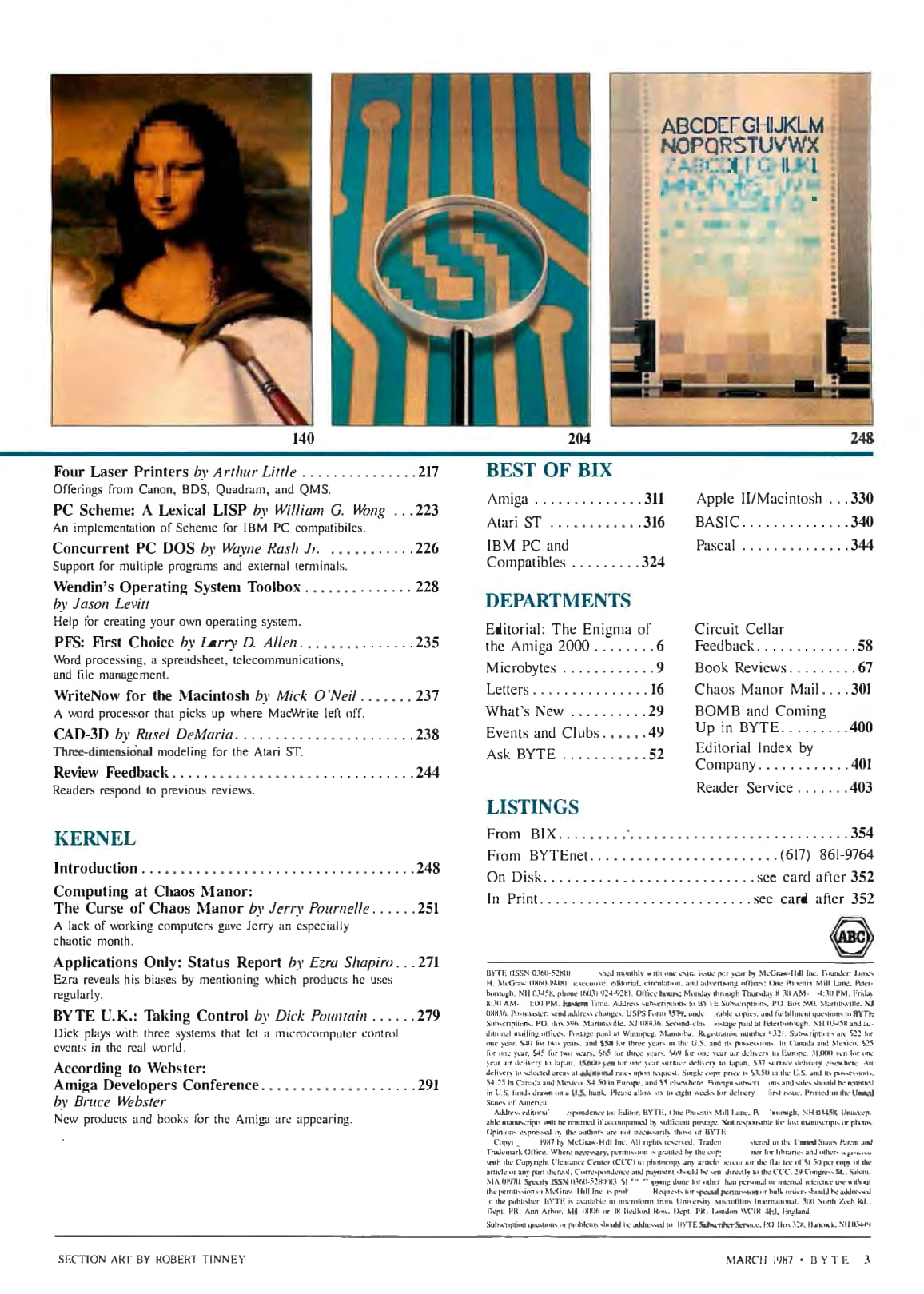
Table of Contents from the March 1987 issue of Byte (continued)
Best of BIX
- Amiga - Printer driver problems (and some solutions) plus slow circle/ellipse routines in Aztec C.
- Atari ST - A discussion of the Atari ST disk format and determining the status of shift/control/alt keys.
- IBM PC and Compatibles - Techniques to prevent accidentally formatting your hard drive and more.
- Apple II/Macintosh - Speeding up compile times on the Mac, BLOADing a text file in DOS 3.3, accessing a clock through ProDOS on the Apple IIgs, and booting from a RAM disk on the IIgs.
Departments
- Editorial: The Enigma of the Amiga 2000 - An intro to the Amiga 2000; the BYTE Information Exchange exceeds 12,000 users prompting an upgrade to the existing 1986 era Arete supermicrocomputer that runs it; and more.
- Microbytes - University of California uses Ped-Pak genetic management software to help endangered animals; Synaptics Inc. plans neural net chips; Atari plans 32-bit Atari ST workstations; Common LISP evolving to support object-oriented features; and much more.
- Letters - Letters from readers about text editing standards, CRT safety, type of sorts, text compression, ZBasic, and more.
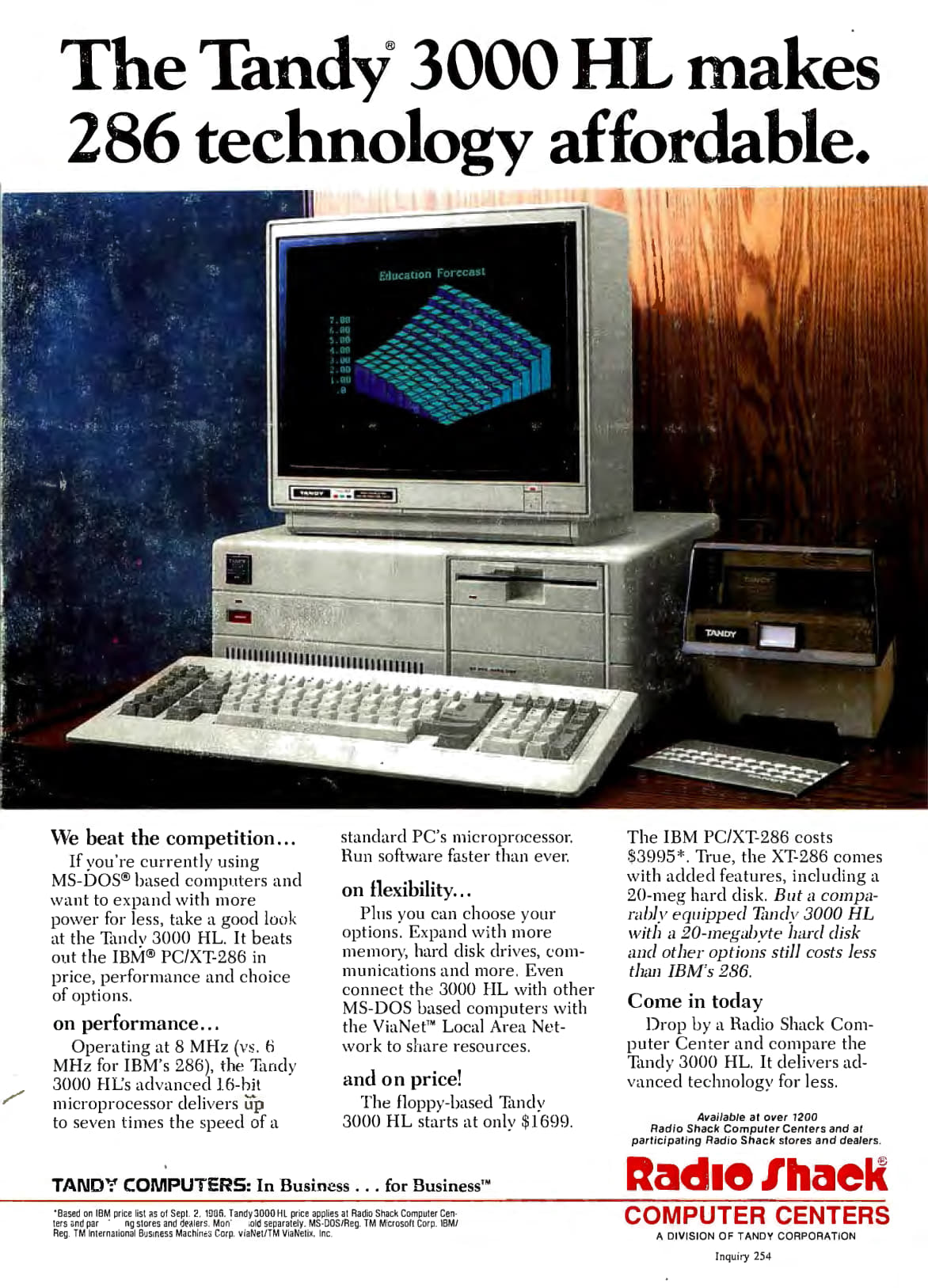
Back cover of the March 1987 issue of Byte
Read more: https://www.megalextoria.com/wordpress/index.php/2024/06/02/byte-march-1987-cover/
Net Neutrality Is Not about ‘Saving the Internet.’ It’s about Controlling the Internet
In 2017, late-night host Stephen Colbert told his audience that it was “a sad day” because the Federal Communications Commission (FCC) had voted to repeal Net Neutrality, an Obama-era rule that required Internet Service Providers (ISPs) to offer “equal access” and speeds to all lawful websites and content regardless of their source, and prohibiting “fast lanes” for certain content.
“What that really means, it means repealing regulations that prevented your Internet provider from blocking certain websites or slowing down your data,” Colbert said. “Now they can. And that’s wrong.”
Repeal of these regulations didn’t just portend the death of the Internet. It marked the triumph of Russia, Colbert suggested, pointing to FCC Commissioner Jessica Rosenworcel’s claim that a half-million public comments came from “Russian email addresses.”
“C’mon, Russia,” Colbert said. “Can’t you just leave America alone?”
The implication was clear. Killing Net Neutrality would destroy the Internet (and may have been a Putin plot).
Colbert was not the only person to make such claims, of course. Senate Democrats said that if we failed to save Net Neutrality, we’d get the Internet “one word at a time.” Actor Mark Ruffalo said that repeal was an “authoritarian dream,” and actress Alyssa Milano called it a threat to democracy itself.
CNN was slightly less hyperbolic, calling repeal of the regulation “the end of the Internet as we know it.”
Six Years Later
CNN was right, in a sense. The repeal of Net Neutrality — which occurred in 2018 with the FCC’s “Restoring Internet Freedom Order” — did mean the end of the Internet as we knew it.
Anyone reading this article can see the Internet didn’t die (hooray!). But few may realize just how much the Internet has improved since Net Neutrality was repealed.
Data released by FCC commissioner Brendan Carr, the former general counsel of the regulatory body, show that not only did the Internet not die; speeds got exponentially faster. According to data from Ookla, a global leader in Internet access performance metrics, median fixed download speeds have increased by 430 percent since 2017. Median mobile download speeds have increased even more — by 647 percent, a more than sevenfold surge.
Internet speeds didn’t just get faster, however. They became less expensive in real dollars.
“In real terms, the prices for Internet services have dropped by about 9 percent since the beginning of 2018, according to BLS CPI data,” Carr points out. “On the mobile broadband side alone, real prices have dropped by roughly 18 percent since 2017… and for the most popular broadband speed tiers, real prices are down 54 percent…”
This is just one part of the Internet boom that occurred following the repeal of Net Neutrality. As the Wall Street Journal recently noted, Internet access also exploded.
In 2015, 77 percent of Americans had access to high-speed broadband. By January 2020, that figure had risen to 94 percent, and it didn’t stop there, the paper notes. In 2022, some 400,000 miles of fiber were laid by broadband engineers — more than double that of 2016.
All of this investment didn’t happen accidentally. It was spurred by a return to laissez-faire Internet regulations reminiscent of the earlier days of the Internet, and was predicted by those who opposed Net Neutrality.
“It’s basic economics,” former FCC head Ajit Pai said. “The more heavily you regulate something, the less of it you’re likely to get.”
Pai’s point deserves attention. Supporters of Net Neutrality argued that the policy was necessary to keep ISPs in line so they didn’t rig the game against consumers in pursuit of higher profits.
But it was precisely the lack of regulation (and the pursuit of profits) that spurred the Internet boom. Companies seeking profit poured capital into Internet services in an effort to attract customers by offering a better, faster, and less-expensive product than their competitors.
Internet prices fell and service improved as a result, despite widespread fears that it would result in the “end of the Internet.” Why so many leftists might have genuinely believed the Internet would break without a federal bureaucracy holding its hand can perhaps be found in the views of the father of socialism, Karl Marx.
Marx saw competition — especially market competition — as a destructive force:
Competition engenders misery, it foments civil war, it ‘changes natural zones,’ mixes up nationalities, causes trouble in families, corrupts the public conscience, ‘subverts the notion of equity, of justice,’ of morality, and what is worse, it destroys free, honest trade, and does not even give in exchange synthetic value, fixed, honest price. It disillusions everyone, even economists. It pushes things so far as to destroy its very self.
The great Austrian economist Ludwig von Mises knew better. He saw market competition as the engine of economic production — “the sharper competition, the better” — which is why he disliked comparisons of competition to war.
“The function of battle is destruction; of competition, construction,” he noted in his 1922 book Socialism.
The Revival of Net Neutrality
The rapid expansion of Internet services over the last six years shows that Pai and Mises understand economics better than Net Neutrality proponents (and Karl Marx). Deregulation spurred investment and market competition, which ultimately resulted in a better Internet — not the end of the Web.
Alas, even though the apocalyptic predictions never materialized, Net Neutrality is back.
Last month, the FCC voted, by a 3–2 margin, to reinstate the policy in an attempt to, in CNN’s words, “reassert its authority over an industry that powers the modern digital economy.”
What’s astonishing is that you wouldn’t even know the amazing story about the explosion in Internet services (or the failed predictions of 2017–18) if you read a news story about the reinstatement of Net Neutrality.
The Associated Press mentions not a single word about the failed predictions or the improved speed and affordability of Internet services. Instead, we’re given this nugget from FCC Chairwoman Jessica Rosenworcel: “In our post-pandemic world, we know that broadband is a necessity, not a luxury.”
CNN, PBS, and numerous other media outlets ran similar stories that failed to mention either the doomsday predictions or the explosion of Internet services over the last six years.
One media outlet conceded that the sky didn’t fall following repeal of the regulation, but argued that this was because Net Neutrality never really left, since public scrutiny and state governments kept ISPs in line following repeal.
“And so, it is fair to say we haven’t seen a world without Net Neutrality,” Stanford Law professor Barbara van Schewick, a Net Neutrality supporter, told NPR.
‘Cyber-Libertarianism’ and the Internet
It’s nice to see NPR recognize the value of federalism, one of the most important checks on centralized power in the American system. Yet Schewick’s point that states have the power to regulate ISPs was curiously missing from the #savetheinternet campaigns of 2017–18. And there’s a reason for this.
The reality is, Net Neutrality was never truly about “saving” the Internet. (If it was, we wouldn’t be witnessing new efforts to impose it even though the Internet has grown far more accessible and affordable in its absence.)
Net Neutrality is about controlling the Internet.
From the beginning of the commercialization of the Internet in the 1990s, the US adopted a largely laissez-faire approach to the Internet, a standard set during the Clinton administration.
John Palfrey, a law professor who ran Harvard’s Berkman Center for Internet & Society, said there was a term for this “hands-off regulatory approach”: cyber-libertarianism.
Cyber-libertarianism unleashed a wave of innovation in e-commerce and social media, he said, which led to an explosion of wealth unparalleled in US history with the possible exception of the Gilded Age. And though other countries such as China would also make strides, Palfrey said the results of the laissez-faire approach are apparent.
“The United States remains the undisputed leader in virtually all aspects of the Internet, digital media, and computing early in this new millennium,” he explained in a 2021 Harvard Law School interview.
Yet, Palfrey does not see “cyber-libertarianism” as a success. He regards it as a threat and a failure.
“It made a small number of people — mostly men, mostly highly educated, mostly white and Asian — fabulously wealthy,” Palfrey said. “We need a regulatory regime today for technology that puts the public interest first, with equity and inclusion as a design principle and not an afterthought.”
Like many others, Palfrey believes the Internet should be regulated as a public utility. He believes the current system gives too much to a handful of billionaires “all of whom happen to be men and white.”
Net Neutrality has been sold to the public as a policy that will prevent Internet providers “from blocking certain websites or slowing down your data.”
This isn’t a power politicians and bureaucrats fear so much as they envy, which is why they’re seeking to loosen private control over the most powerful communication system in the world “in the interest of a more just and inclusive economy and our very democracy.”
Once one realizes that Net Neutrality isn’t so much about creating a better Internet as much as a key step toward an Internet under government control, the push to revive the policy makes a whole lot more sense.
This article originally appeared in The Daily Economy at AIER.org.








